21. THE TROUBLED 21st CENTURY

TRUMP AND THE WORLD
CONTENTS
 The 2016 elections The 2016 elections
 The Coronavirus disease - 2019 The Coronavirus disease - 2019
(COVID-19)
 The political outfall in America The political outfall in America
 The American immigration crisis The American immigration crisis
 Venezuela Venezuela
 China China
 Russia Russia
 The world of Islam The world of Islam
 The chaotic 2020 American national The chaotic 2020 American national
elections
The textual material on page below is drawn directly from my work
A Moral History of Western Society © 2024, Volume Two, pages 424-434.
The
Democrats put forward as their presidential candidate Hillary Clinton …
clearly moving down the Progressivist or post-traditionalist road in
doing so – and expecting a dazzling electoral victory in the 2016
presidential elections in doing so. But weren't they shocked when the
person who represented most vividly the traits that Progressivist
America deplored won the election. How did this happen?
Apparently there were still a "basketful of deplorables" out there,
conservative voters as Hillary herself termed them ... unable to see
the moral picture clearly. And thus they voted for the highly
ego-centric and theatrical (thus true Boomer) Donald Trump. But the
reaction was immediate. Not only in America but across the world masses
of people (mostly youth … and women dressed in pink) turned out in huge
numbers to declare that Trump was "not my president."
Impeach, impeach, impeach
And immediately action was taken up by Congressional Democrats to find
grounds to impeach Trump as quickly as possible. And they found
documents (paid for by the Hillary election campaign) that supposedly
connected Trump with some kind of Russian conspiracy to have him rather
than Hillary elected as US President. And surely these offered the
legal means to impeach Trump.
However, an investigating committee they assembled did not come up with
the results they wanted – after a two-year effort to find something by
which to bring Trump down. So they tried again, basing their second
impeachment effort on the way Trump held off American payments to
Ukraine until Ukrainian corruption could be cleaned up a bit ...
implicating Democratic leader Joe Biden's son in the corruption matter.
But the Democrats backed down when they realized bringing Joe's son
Hunter into the discussion would hurt rather than help their
impeachment effort. So they simply switched to Trump's impeachment on
the basis of his refusal to honor subpoenas demanding his appearance in
front of the Democratic-controlled Congressional committee pursuing the
impeachment possibilities.
Tragically, all this pointed out how deeply America was divided. There
seemed to be no middle ground between Republican Party "conservatives"
and Democratic Party "progressives" splitting the country into two
hostile communities. And the media was no help in the matter, slanting
the "news" – again, mostly just deeply ideologized social commentary –
on the one hand in support of the "Trumpian" Republicans (mostly Fox
News) and, on the other hand, in support of Trump's dedicated opponents
(mostly all the other national media).
Trump's flamboyant personality
And Trump was no help in the matter. He had no professional experience
in public office ... and seemed totally unaware of the niceties
required to make a contentious political engagement not go up in
flames. Indeed, besides being a very wealthy, very successful, urban
construction magnate, he was a host for years of a widely-watched TV
program … one that delighted in bring in contestants and then cutting
them down ("you're fired") in some kind of competition for larger
service in the community. Trump used that same TV flare to undercut his
fellow Republican contestants in the 2016 race for the Republican Party
presidential candidacy. He termed his election opponent "Crooked
Hillary." But even before that, in the Republican primaries he termed
his opponents "Little Marco" (Senator Marco Rubio) or "Lyin' Ted"
(Senator Ted Cruz). About Florida governor Jeb Bush (another son of
Bush, Sr.)
| Jeb
failed as Jeb! He gave up and enlisted Mommy and his brother (who got
us into the quicksand of Iraq). Spent $120 million. Weak no chance! |
He even went after former Republican presidential candidate – and well-recognized war hero and national patriot John McCain:
| . . . not a war hero, he's a war hero because he was captured. I like people that weren't captured. |
In this he would foolishly make dedicated opponents of the McCain organization. But Trump seemed not to care.
Trump simply had no idea of how to build support among any except those
willing to follow him slavishly. He had his wild supporters of course.
He built a huge Trump following around his "Make America Great Again"
(MAGA) theme. But he seemed unable or just unwilling to bring the
all-important political "center" to his support. That would require
compromise. And he was just not interested in such political niceties.
Theatrics seemed to be the only strategy (if you can call it a
strategy) that he was willing to employ to get things done. But in
this, he was fairly correct in understanding how political fortunes
were made. It was critical to keep the media focused on you as a
political candidate … hopefully positively. But any attention, even
negative, served higher political purposes at this point in the
American culture.
He used those theatrics a bit in his effort to develop a Trump "foreign
policy" ... although what that exactly amounted to was never very
clear. He seemed to repulse most of his European allies. Germany's
longstanding Chancellor Angela Merkel clearly disliked Trump … although
she did her best to keep Germany on excellent working terms with its
American ally. And neither Russia's Putin nor China's Xi seemed to have
much regard for Trump. And whatever new relationship he thought he was
building by way of his visits with North Korea's Kim Jung-Un seemed to
go nowhere.
|
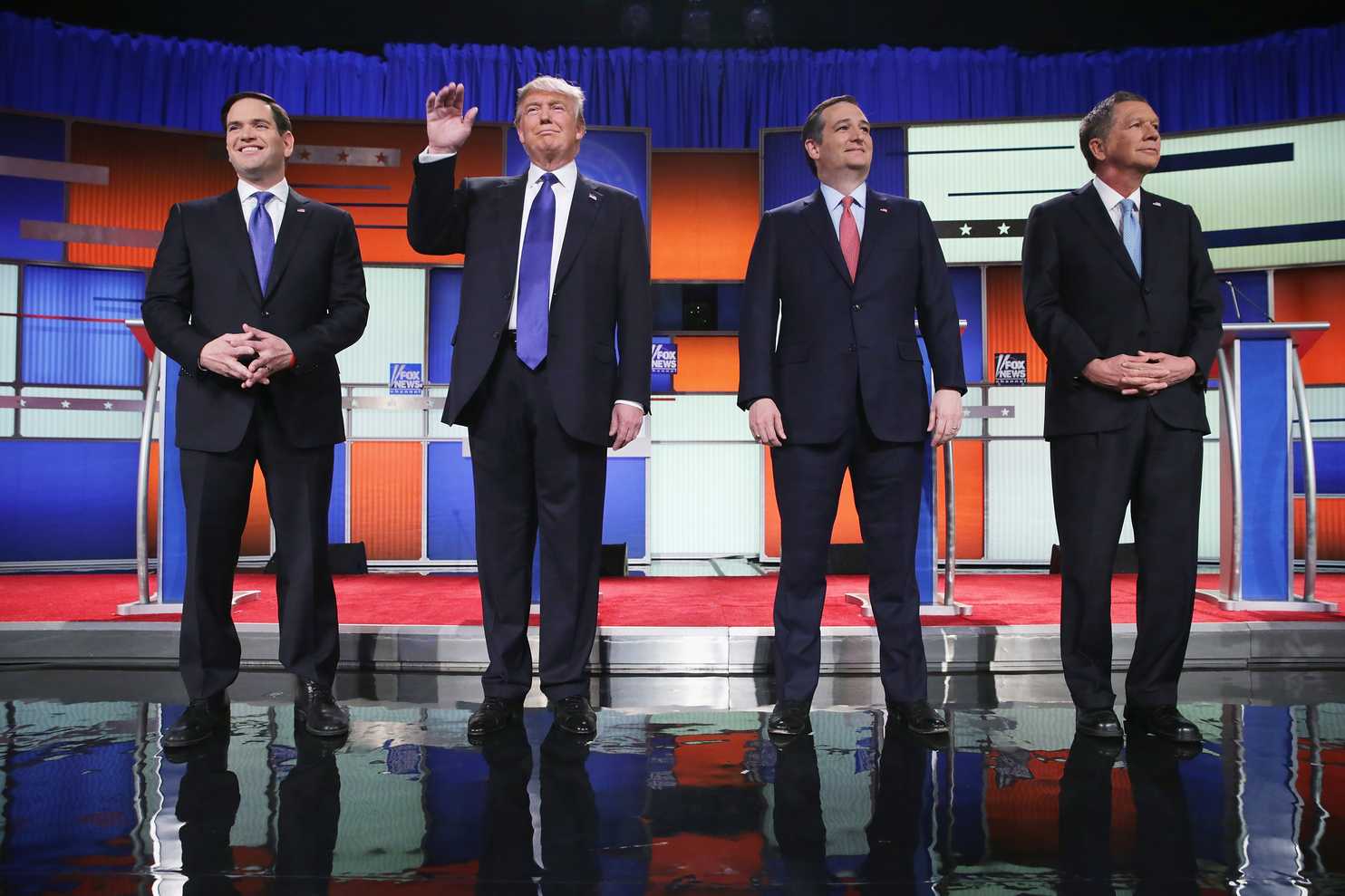
By March 3, 2016, at the 11th
Republican debate, the number of Republican contenders
was down to four: Marco
Rubio, Donald Trump, Ted Cruz and John Kasich
(with – as usual – Trump dominating
the conversation)
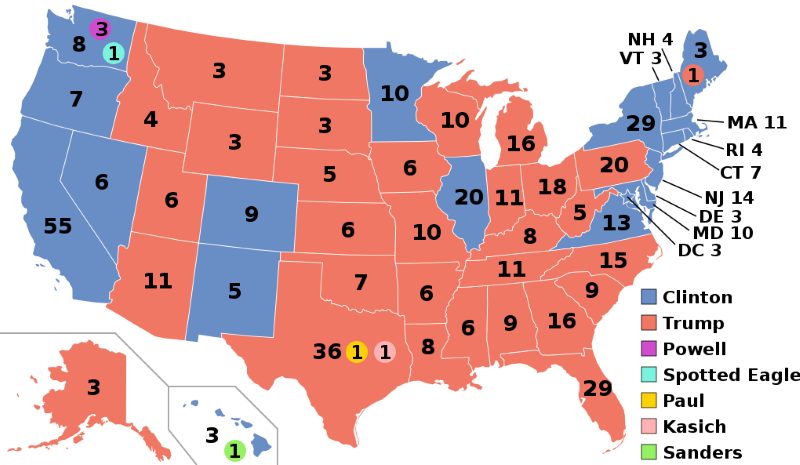

Trump taking the oath of office,
with his wife Melania holding the Bibles
on which he pledged his
service
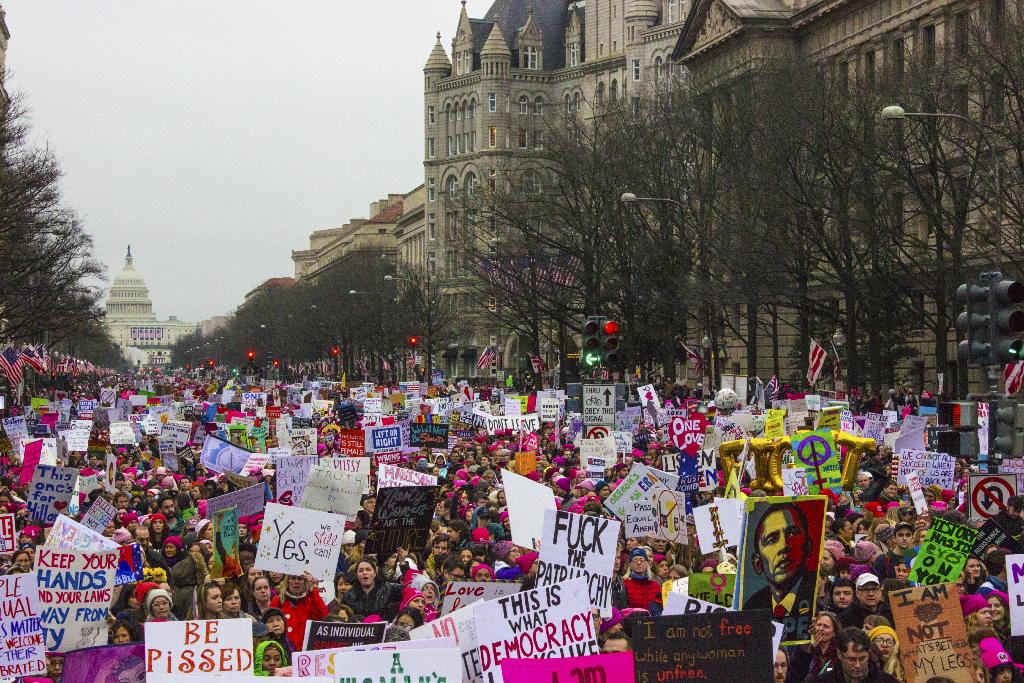
The anti-Trump Women's March
in Washington, DC on January 21st (the day of his inauguration!)
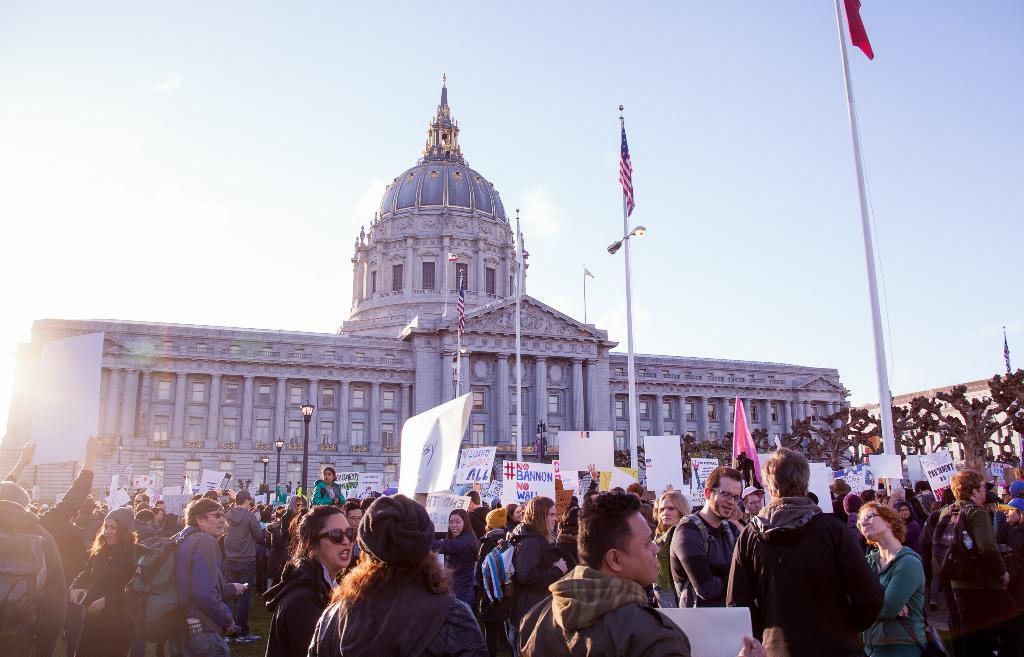
The anti-Trump protest in front of San
Francisco's City Hall on February 4th
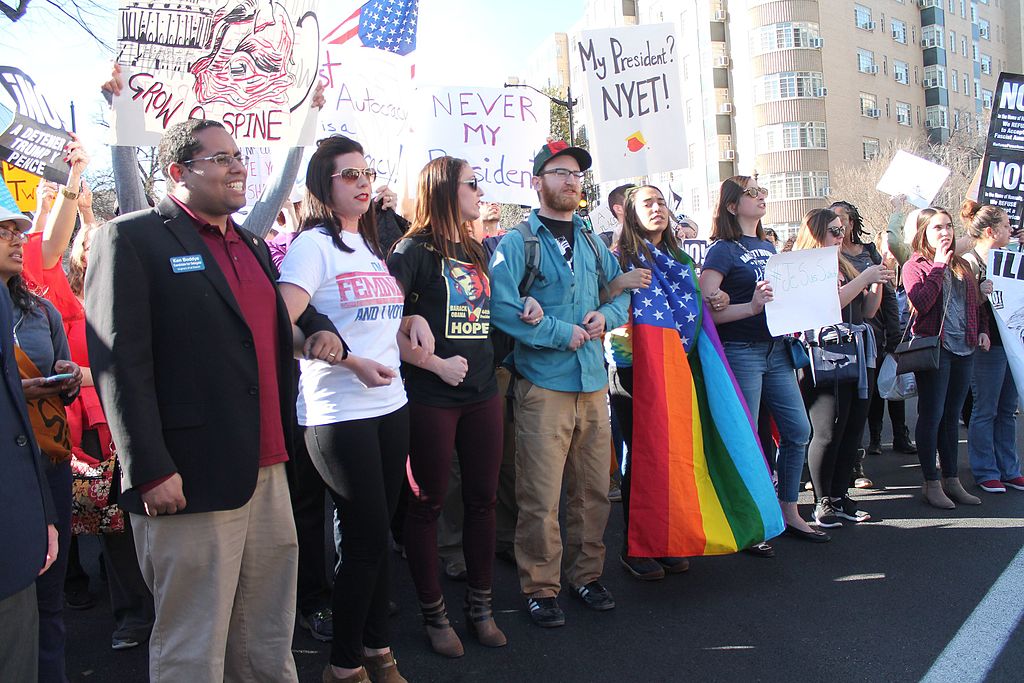
"Not My Presidents Day"
demonstration headed toward the White House – February 20th
Early calls to impeach Trump
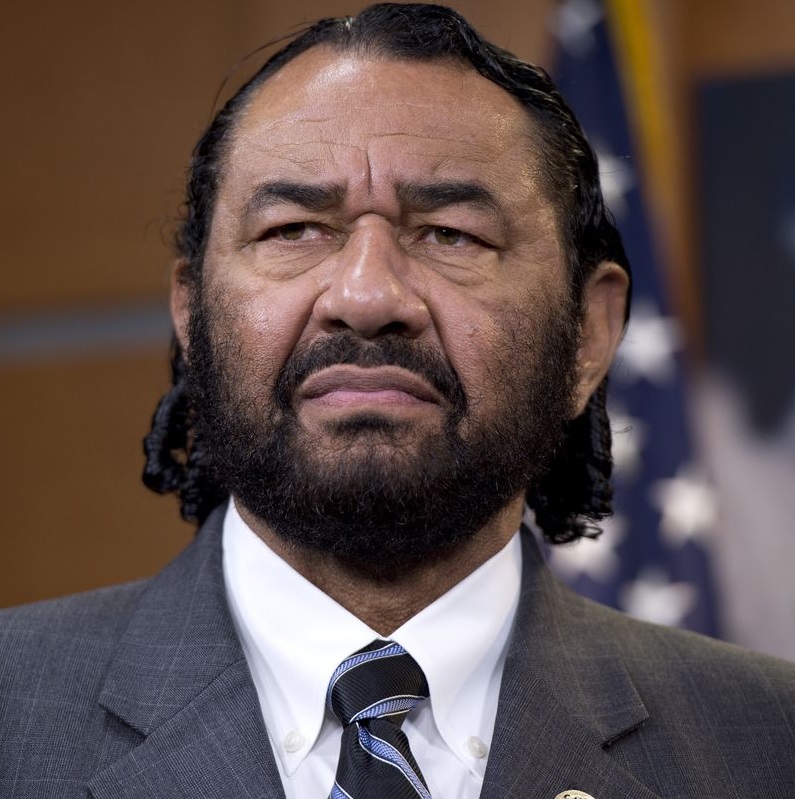
Leaders in the
effort to impeach Trump (started even before Trump's inauguration):
Rep. Al
Green (Democrat – Texas) above / Rep. Maxine Waters (D-California) below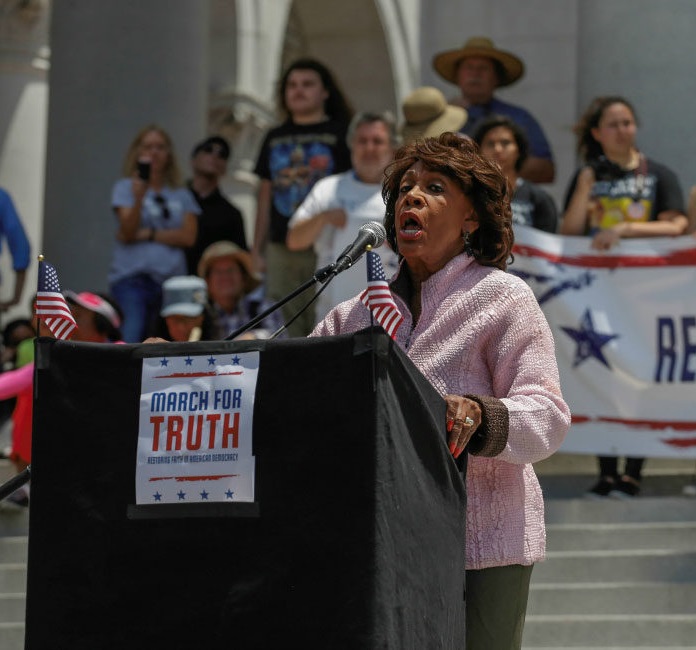

In the Senate, leading the effort to find
something on Trump to bring him
to impeachment is Elizabeth Warren
(D-Massachusetts).
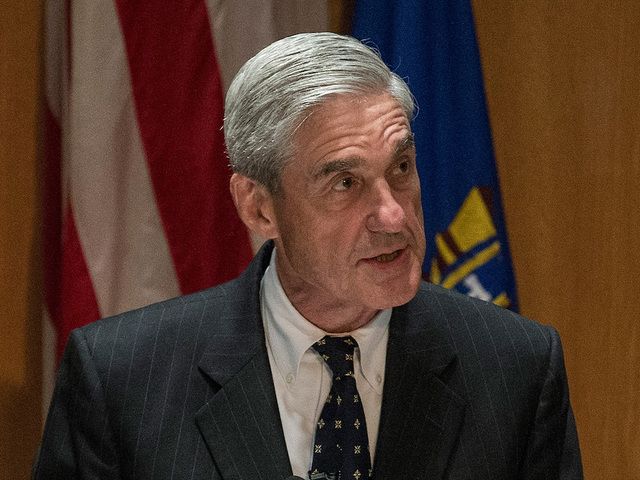
On May 17th (2017) Robert Mueller, longtime FBI Director
(2001-2013) was appointed as a Special Investigator to look into this matter of the
Russian involvement in the 2016 election.
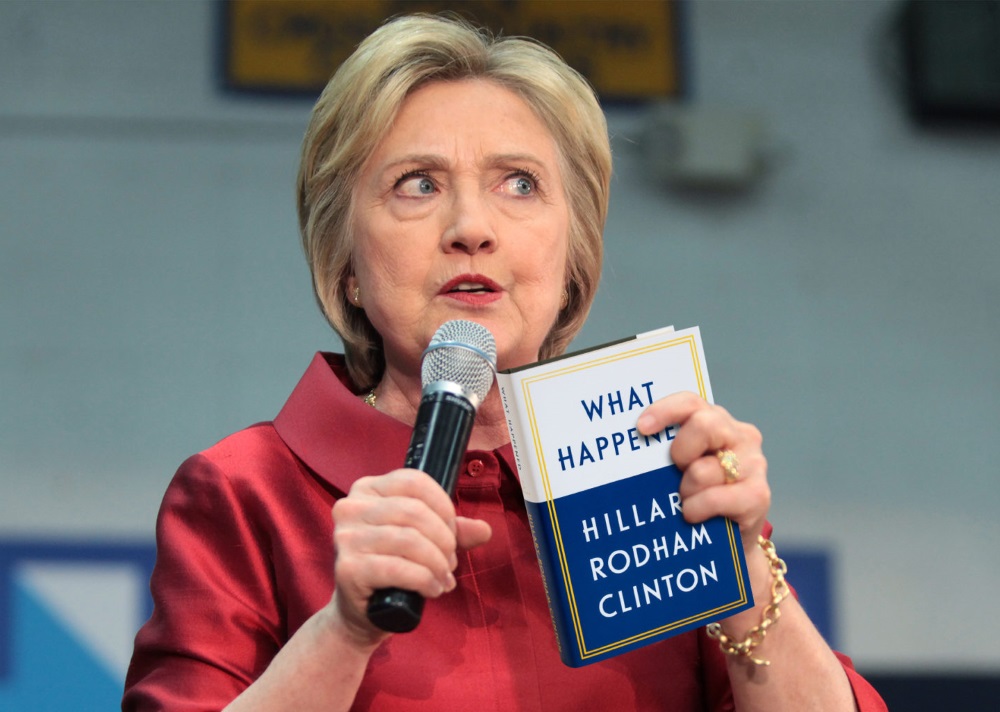
July 2017 – Hillary Clinton came out with her new
book, What Happened, explaining all the
things
that acted against her to cause her to lose the Presidential election.
The "Russian connection"
plays big in the
narrative.

With the Democratic Party Nancy Pelosi back in command in the House after the 2018
elections, the world waited to see how she was likely to proceed with the Democrats'
"impeach Trump any way you can" mood. However ... The results of the Mueller committee investigation, announced two years later (March 2019),
will find no basis to bring charges against Trump ... disappointing the Democrats deeply.
THE CORONAVIRUS DISEASE - 2019 (COVID-19) |
Covid-19's
global impact (2020-2021). An outbreak of the Coronavirus in Wuhan
China in December of 2019 soon spread to the rest of the world in early
2020. When first Italy and Spain were hit particularly hard, they
underwent a "lockdown" – keeping people in their homes, allowing them
out only for such "essential services" as food shopping. Soon the idea
was taken up by other countries … and by the different states in
America. Restaurants, schools, churches, were shut down by governmental
order … and the streets became deserted. But even then, by March, both
Italy and America had overtaken China in the number of deaths reported
from the virus.
Due to the similarity to previous Coronavirus outbreaks – the SARS
virus (severe acute respiratory syndrome) in 2002-2004 and the MERS
virus (Middle East respiratory syndrome) in 2012-2015 – vaccines to
fight the virus were finally brought to production … notably first in
America, then Britain (early spring of 2021) and by mid-2021 the Euro
area and Canada.
According to the best estimates, these vaccines ultimately saved the
lives of anywhere from 15 to 20 million deaths globally. But even then,
as of October 2021, it was reported that some five million people
globally had died from the virus. Hardest hit – in terms of population
percentages – tended to be Latin American and East European societies.1
The reopening of that closed-off existence was very gradual – crashing
the economies of the world's societies as work came to a halt during
those days of lockdown. America's economy declined by 9 percent in the
second quarter of 2020. But for other industrial societies, the figures
were worse: In the same quarter, Britain's economy declined by 21.4
percent; in the larger Euro area the figure was 12.4 percent, Canada
12.4 Percent, and Mexico 19 percent. Needless to say, the economic
decline was at least as bad, if not worse – though precise figures are
hard to come by – in the Third World.
However … China actually benefited greatly economically from all this,
pulling out of its Covid-induced economic downturn very quickly …
thanks to its government's infrastructure spending. In fact, because of
the huge demand for Chinese goods still being produced while the rest
of the world remained in its economic shutdown stage, China's economic
growth reached nearly 30 percent in 2020! But this then allowed the
Chinese government to slow its economic support for its industry in
2021, slowing the country's economic growth somewhat.
At the same time, massive inflation hit the world as markets reopened …
and prices skyrocketed for the small amount of production available for
sale at that point.
1For
America, that number was 827,000 deaths. Globally the 5 million count
probably is rather low, as Third World countries did not collect data
adequately. In fact, it is speculated that in India alone, over 4
million people may have died of the virus.

The Wuhan wet market
It is widely
believed that the horrible corona-virus epidemic that cut across the
world began in this wet market in Wuhan China. Others speculated that it may
have started in a Chinese biological research lab ... and got carried to that
market. Others have different theories on the origins. Chinese were
even to claim that it got started by American agents!
|
In any case, as with the rest of the world, the virus hit America hard!
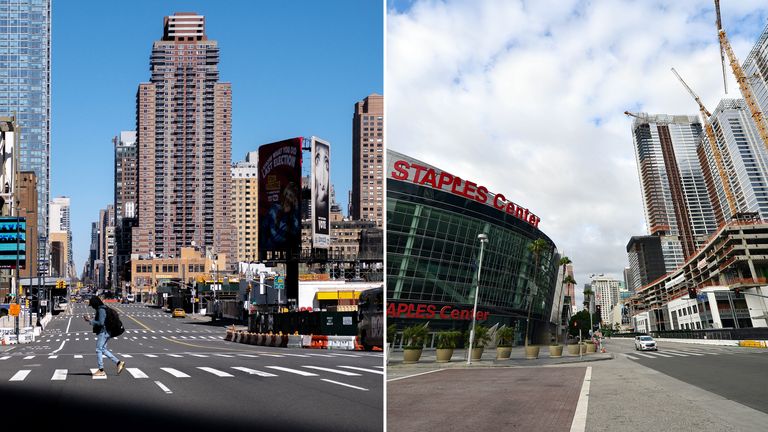
New York City for instance
As
the virus spread westward hitting Europe hard and then heading towards
America, Trump shut down flights into the country from China, and put
deep restrictions on other flights into the country. Democrats
immediately complained that Trump's actions were entirely imperious.
Then later, as the virus did indeed hit America, he was criticized
bitterly by the same voices "for not having acted soon enough."
Indeed, his discussions at press conferences (typical of the
times) turned political ... as the media made what it wanted of his
explanations, either supporting his efforts to act against the
virus or attacking him for the way he said this or that.
In
any case, this national crisis did not bring the country together ...
but once again seemed only to give political opportunists yet another
cause to go against their ideological opponents. |
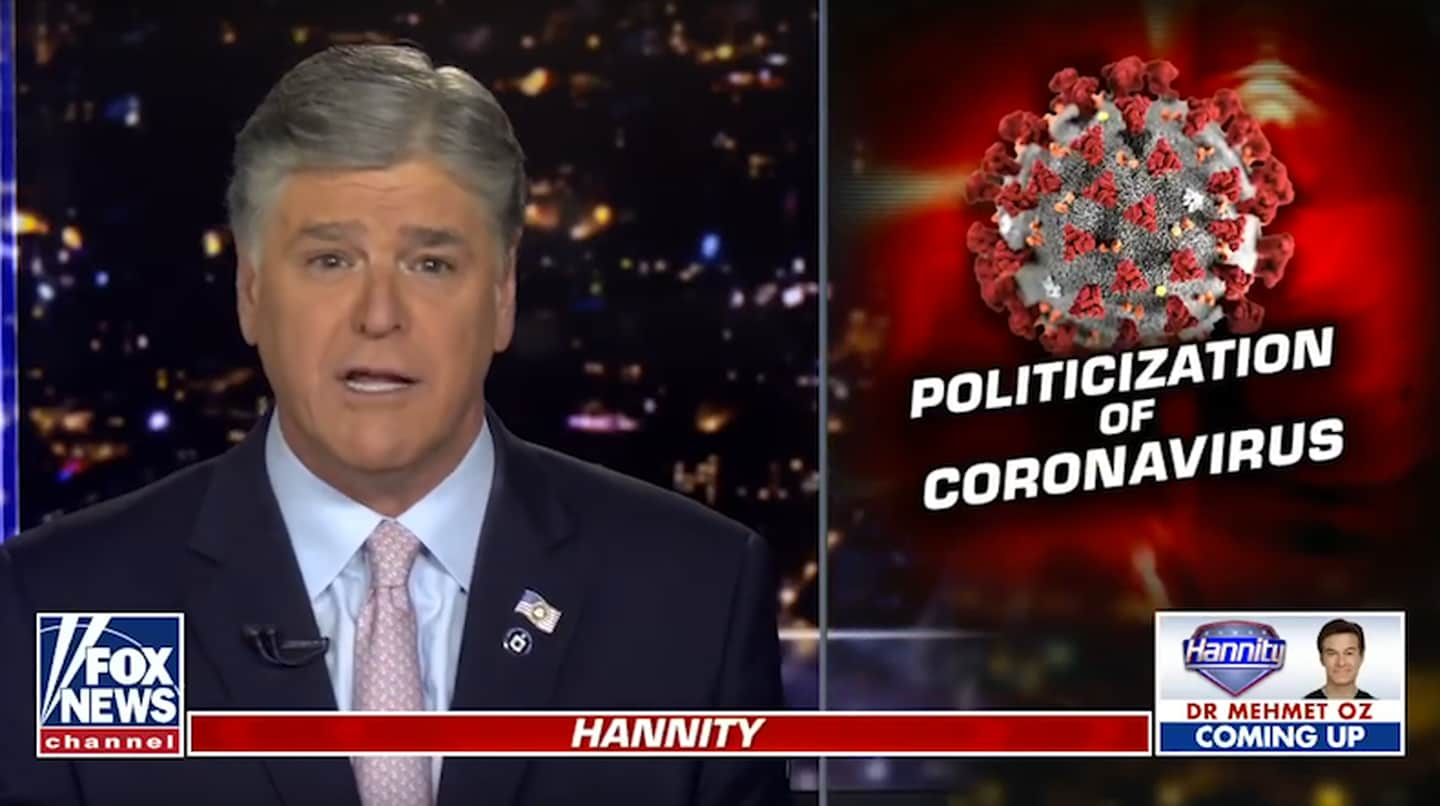

The Philadelphia Inquirer – March 11, 2020
Another casualty of the corona-virus crisis was the Stock Market, which tumbled as the country's businesses were forced to close down on a "stay-at-home" order imposed by state after state as the panic spread.
THE POLITICAL OUTFALL IN AMERICA |
|
Congress gets in on the act
In early March, Trump authorized $8.3 billion in emergency funding for
hospital care and medical research. But by mid-March it was very
apparent that this hardly addressed the depth of the crisis – and thus
Trump requested of Congress $1.2 trillion … not only for medical
support but also to help keep struggling businesses alive. But
Congress's House Majority Party (Democrat) leader Nancy Pelosi
responded with a call for $2.5 trillion instead … which included
funding for Democratic Party goals of educational programming,
environmental support, and other items – items that had nothing to do
with the virus outbreak. Furthermore, her program involved a cutback in
support for the deeply suffering American business world. But she was
going to hold the Coronavirus spending hostage until she got Trump and
the Republicans to move things in her direction. Finally she got the
Republicans to accept a $2.2 trillion spending bill … which included a
$1200 or $2400 grant to every American household (depending on single
or double adult status) … for whatever reasons. All of this added
enormously to the country's national debt.
|
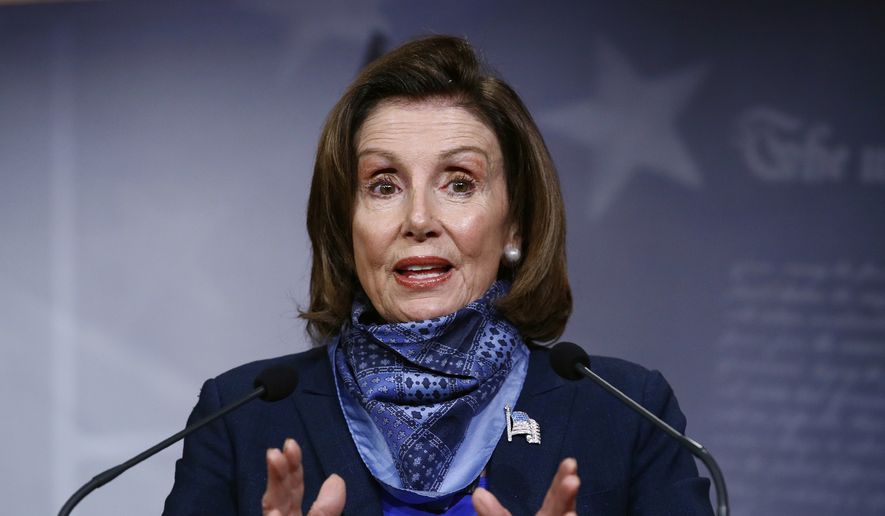
Pelosi explaining the Democratic Party's much greater financial demands
in the economic relief program
The George Floyd tragedy
... and Black Lives Matter
|
But there were other repercussions from the way the virus hit the
American nation.
In May of 2020, a Black man, George Floyd, after being reported by a
store clerk to the police as having used conterfeit money, was taken
down by a White cop, Derek Chauvin, and held to the ground by keeping
his knee on Floyd's neck (for over nine minutes), with an already
somewhat sick Floyd
protesting that he couldn't breathe. Consequently, Floyd died.
All of
this was caught on camera … and shown across all the media, Facebook
and YouTube as well as the national media. Black protests were
immediate and extensive … conducted under the theme "Black Lives
Matter." But this also turned into the occasion for more Black plunder
and torching of American cities across the country.
|

George Floyd is brought down by Minneapolis policeman Derek Chauvin on
May 25, 2020 ... and Floyd dies as a result
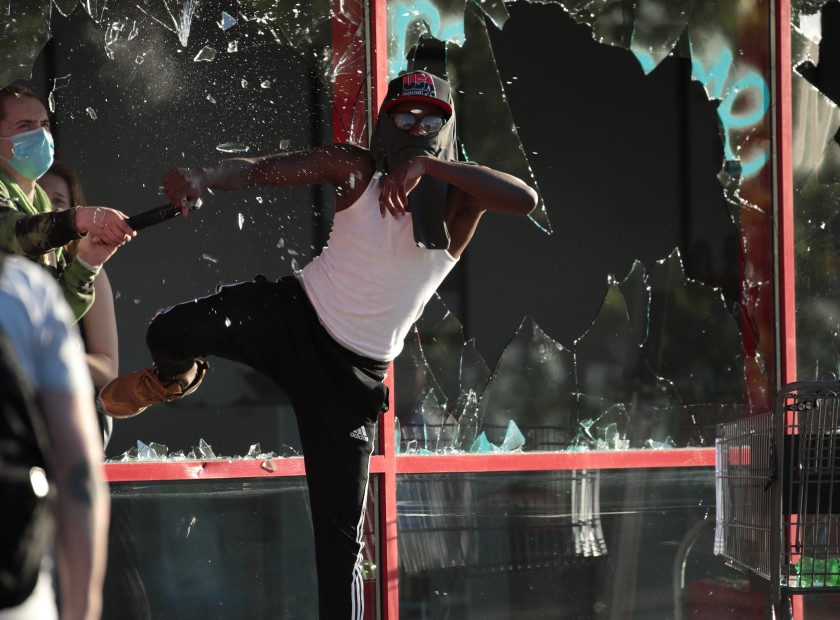
Minneapolis Blacks go on a rampage over the Floyd murder
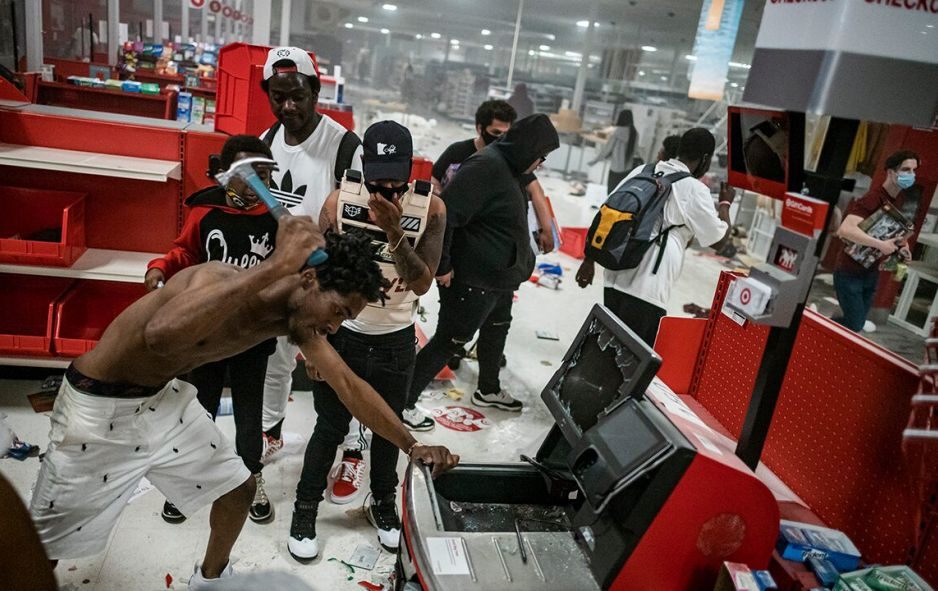
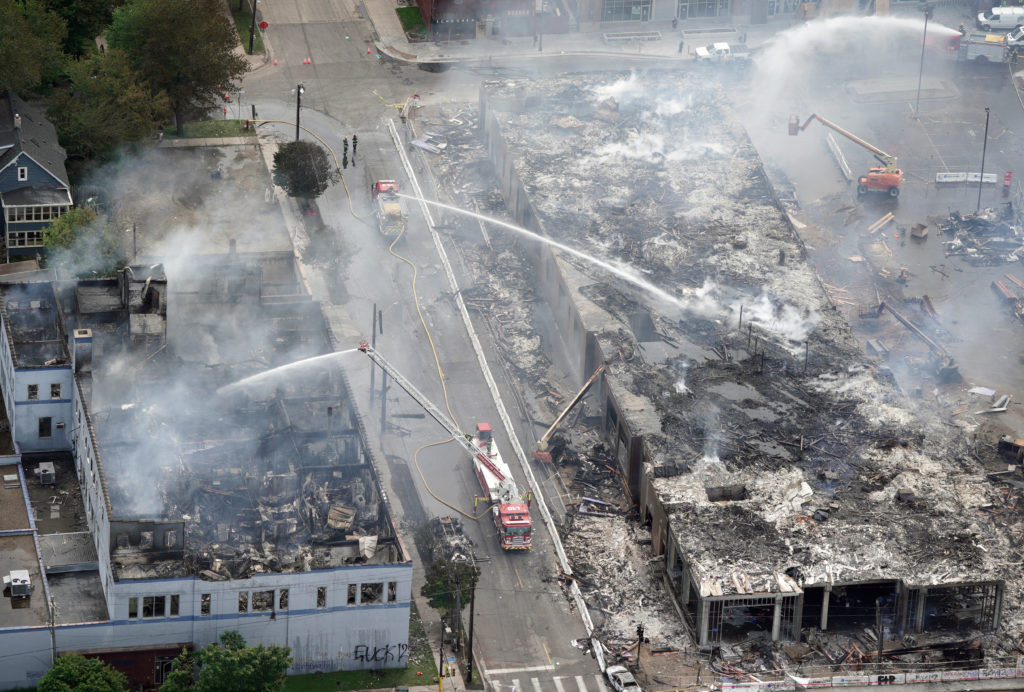
Then the protests spread around the country (late May and into June)
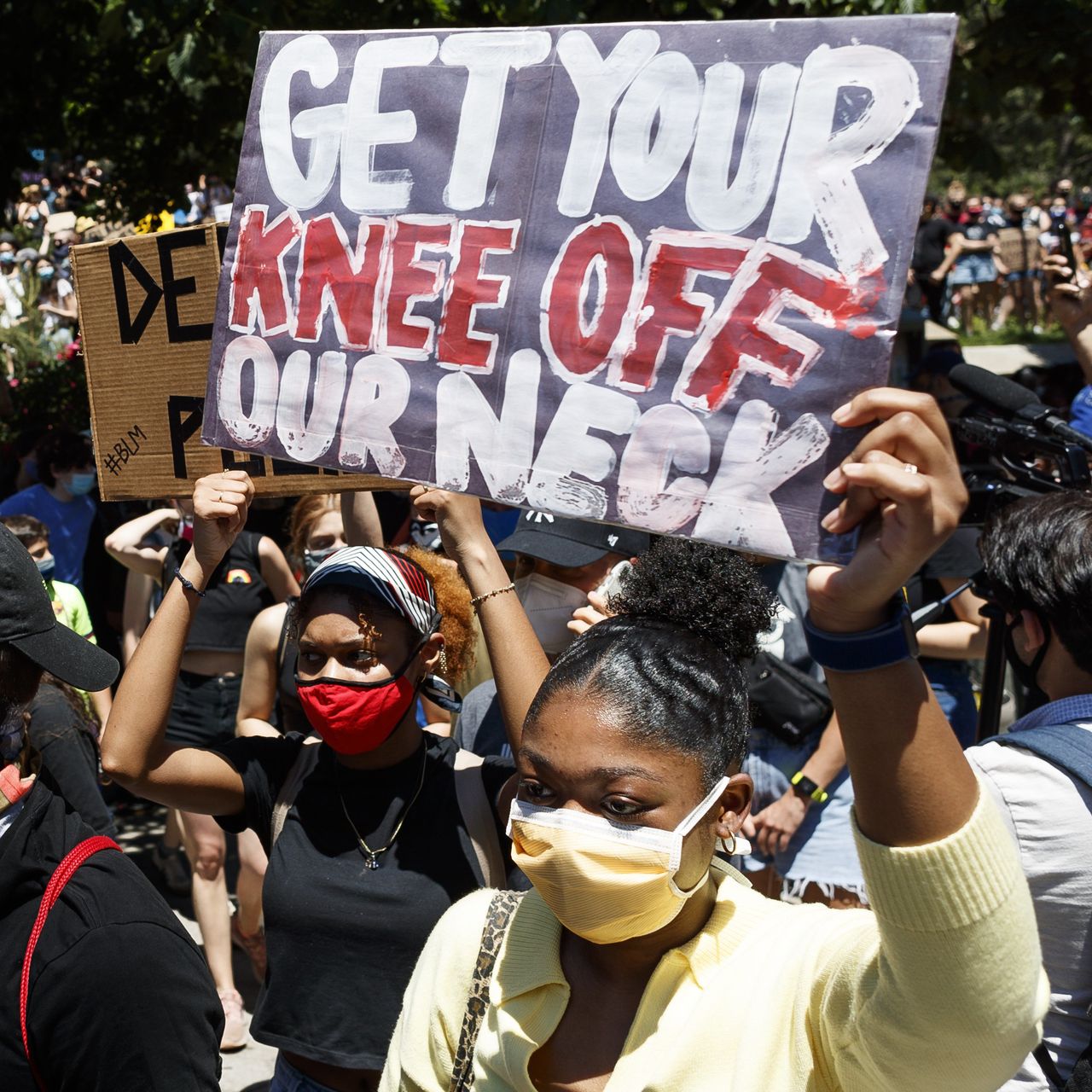
|
"Defund the police"
At the same time, a number of big-city mayors (Liberal Democrats)
joined the furor by announcing that they would be helping to "defund
the police" … transferring police funding to more worthy social causes.
At this point "defund the police" had become a key piece in the
"political correctness" followed closely by aspiring young politicians
(and some of the older ones as well). But this would leave America's
urban police underfunded and soon understaffed, as police retired in
massive numbers in response to this new social mood. Unsurprisingly,
the crime rate in America climbed rapidly as a follow-up.
|
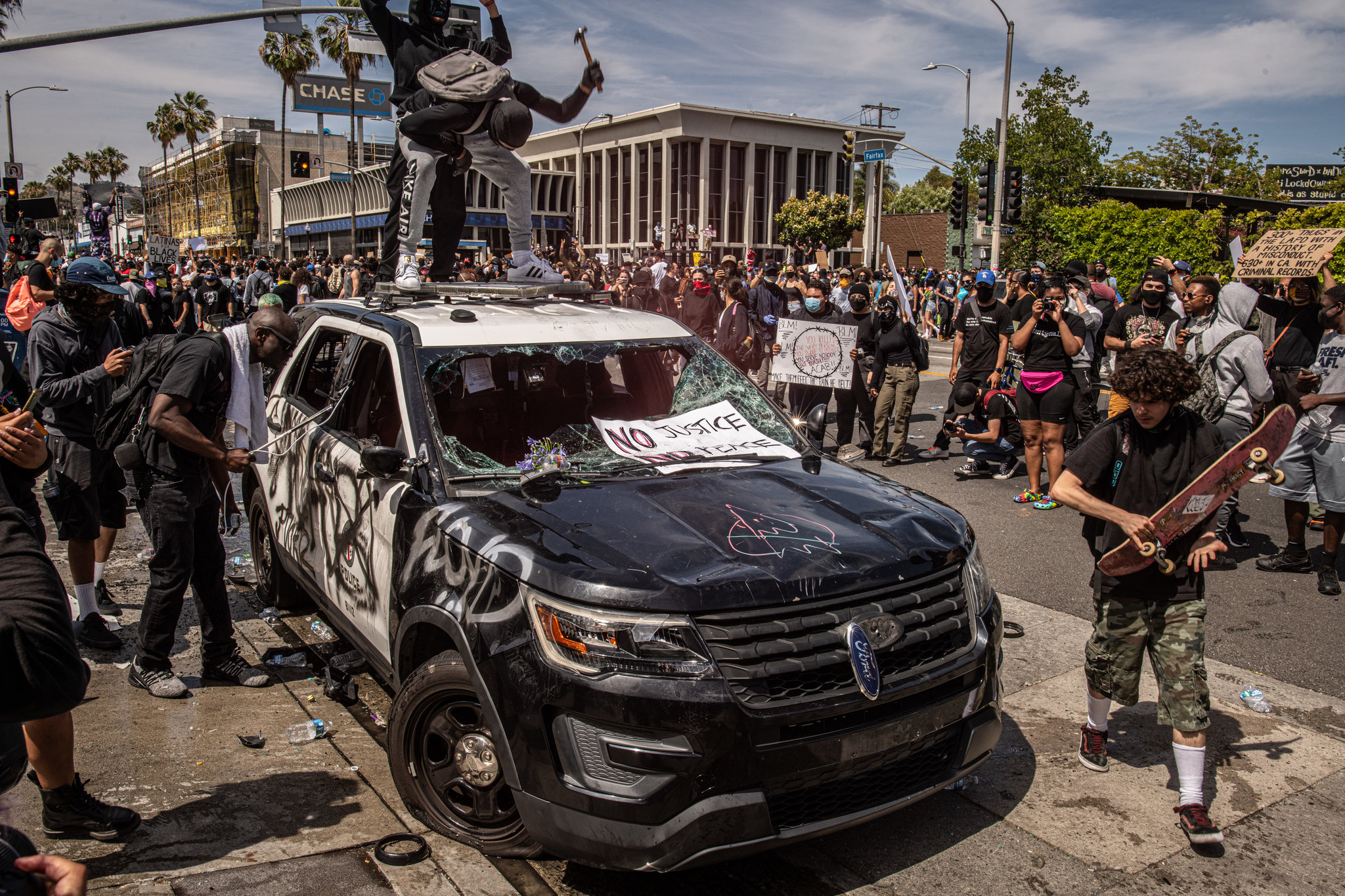
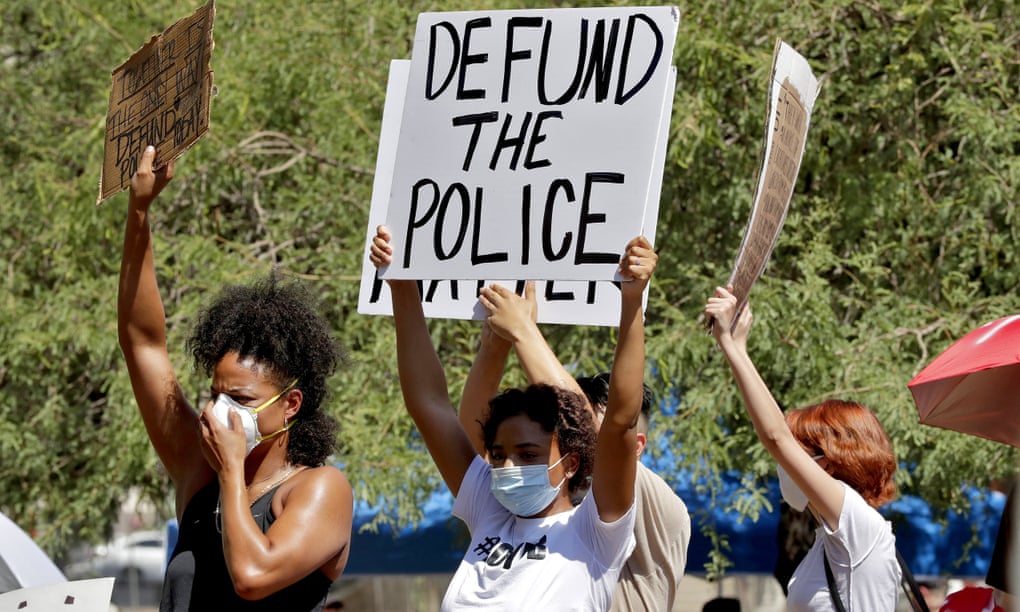
|
Antifa
But this soon inspired young, mostly White "Anti-Fascist" (or "Antifa")
protesters to join the protests – the pandemic restrictions helping
immensely to inspire an Antifa attack on the "Fascist" American police
… called out to bring widespread rioting back under some degree of
control. Indeed, it soon appeared that Antifa believed that it was
conducting some kind of revolution against all social authority –
especially when in June, Antifa youth were allowed to take control of
downtown Seattle and turn six city blocks into their police-free
"Capitol Hill Autonomous Zone" … defended by fully-armed youth.
|
Young Whites felt the strong need to affirm a co-identity with Black suffering

Another of the uglier versions of the days' events took place in Seattle (May 30th)
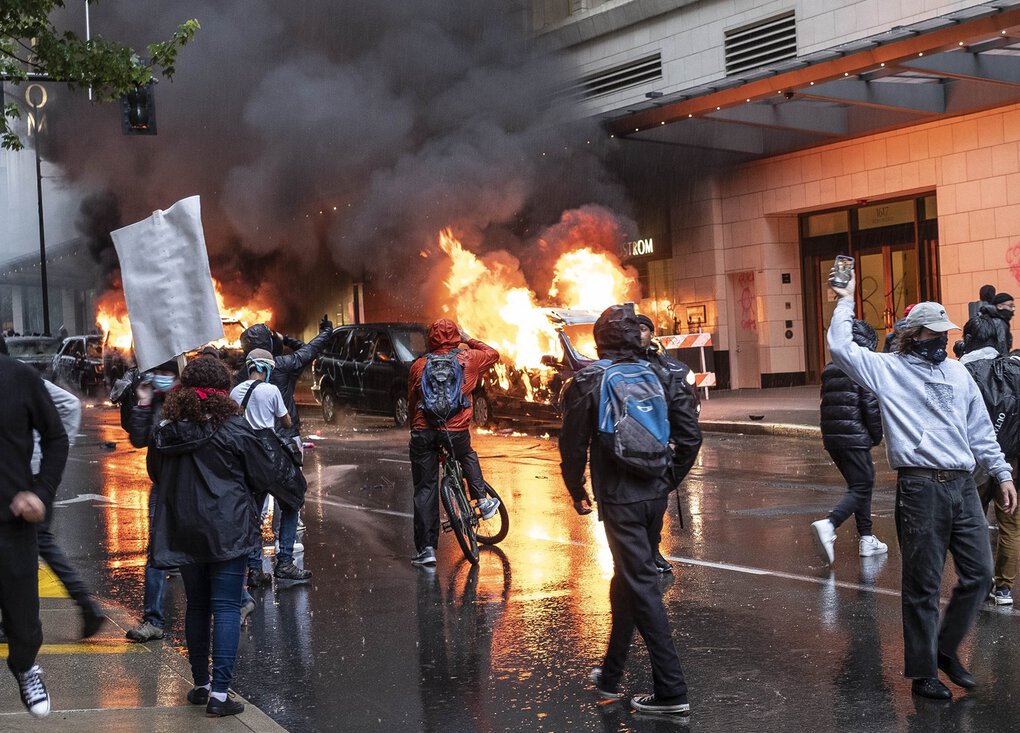
This inspired young "progressives" to take over 6 city blocks in downtown Seattle to create their "Capitol Hill Autonomous Zone" (CHAZ) ... succeeding after two weeks of police and National Guard units versus activist violence ... when the police were ordered to stand down by Chief Carmen Best
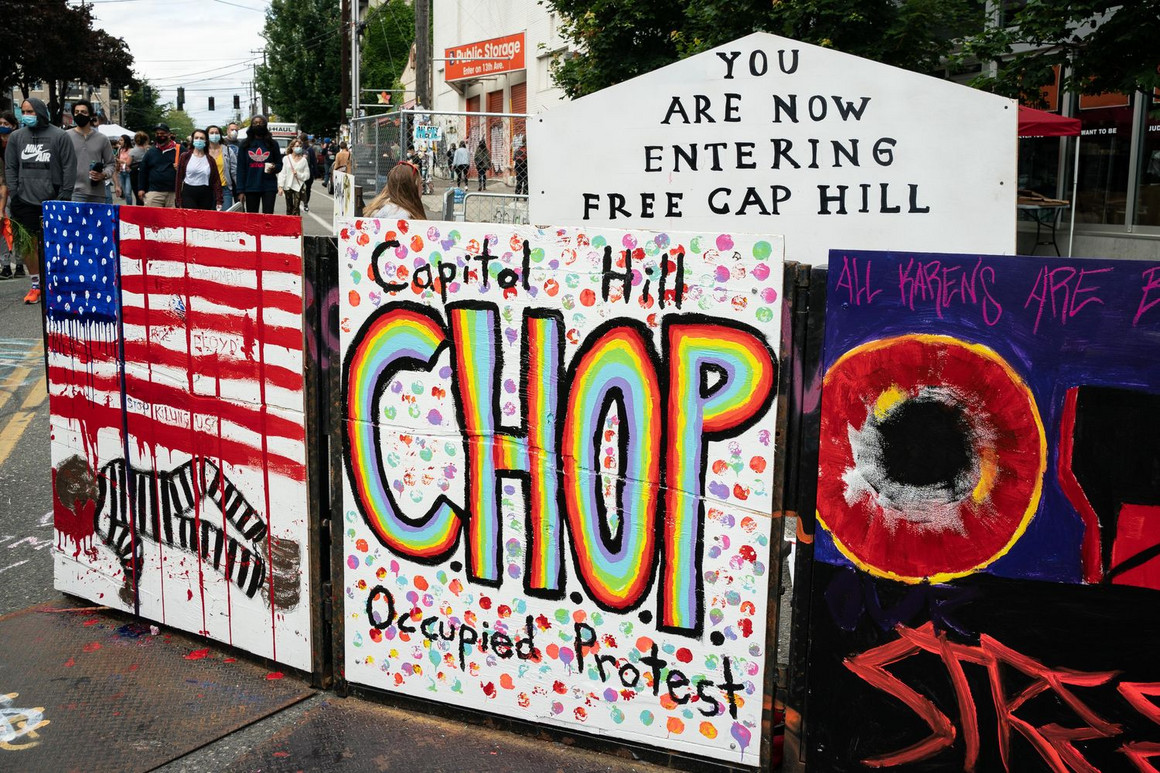

THE AMERICAN IMMIGRATION CRISIS |
The
massive movement of people – mostly across the Mexican-American border
– is not a new thing … with as many as 1.5 million+ apprehended at that
border in the year 2000, a drop in 2003 to 900 thousand, a rise to 1.2
million in 2005, then a drop in 2011 to around 400 thousand. Originally
these were mostly Mexicans seeking refuge in America. But by 2014,
about half of these illegal entrants were non-Mexican, principally from
the three Central American or "Northern Triangle" countries of
Guatemala, Honduras and El Salvador. And by 2014, this number included
a massive increase in the number of "unaccompanied minors" crossing the
border … thanks largely to a 2008 law offering protections for just
such minors – played up by smugglers to increase their businesses.
During his electoral campaign in 2016, Trump promised that he was going
to build a huge fence across the border with Mexico … and make Mexico
cover its costs. There was no way that this was going to happen. But
Trump did what he could in coming to office in doing some building – or
more often, rebuilding – of that wall … some 450 miles of construction
– which Mexico did not pay for! But the overall length of the border is
1,954 miles … offering illegals plenty of opportunity to find their way
into America through the more remote (and more dangerous) routes.
And Trump attempted to block all unregistered entry into America …
requiring migrants claiming asylum rights to register at the border –
and remain in Mexico until they could be processed for entry. As a
consequence, by 2019, there were well over a million individuals
waiting in Mexico for their cases to be heard.
But with the global Coronavirus outbreak, the rate of illegal
immigration across that southern border skyrocketed … and there was
actually very little that Trump could do to stop that huge influx.
|
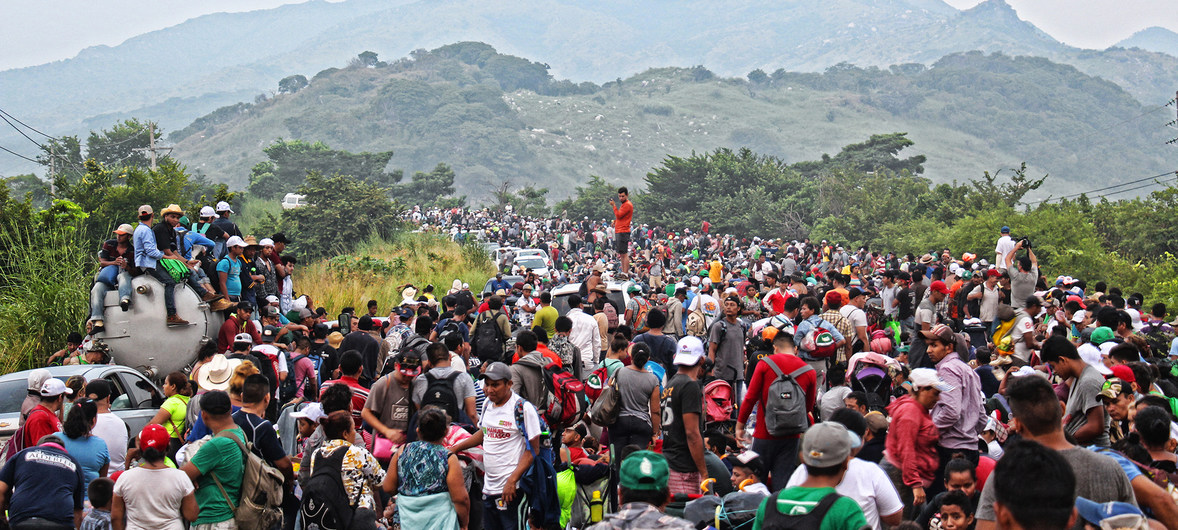
"Caravans" of mostly Central American migrants heading through Mexico to America - 2018

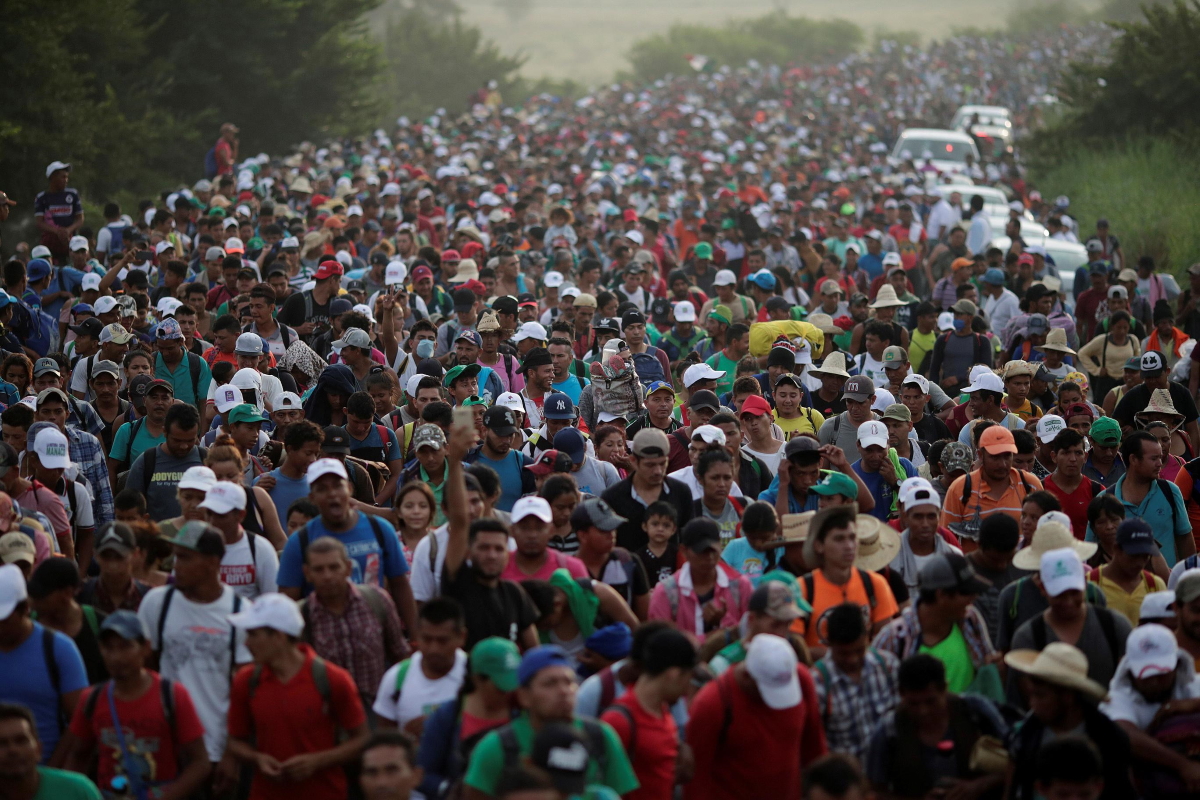
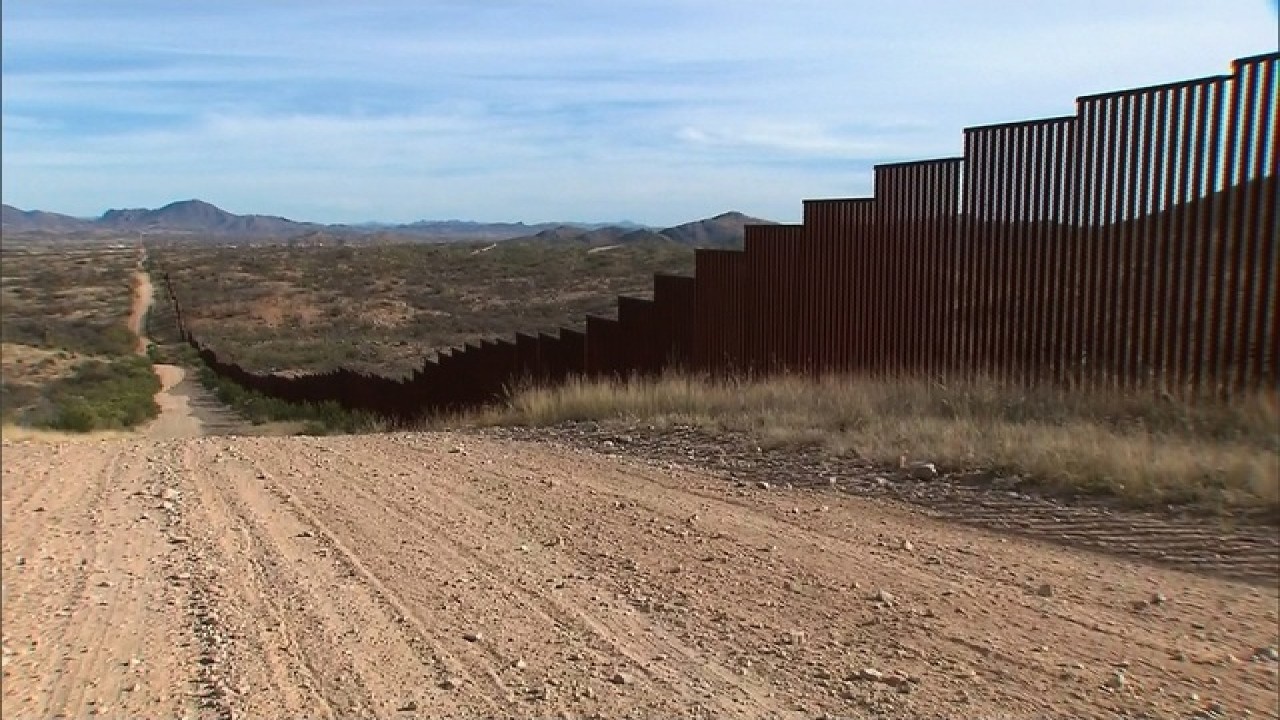
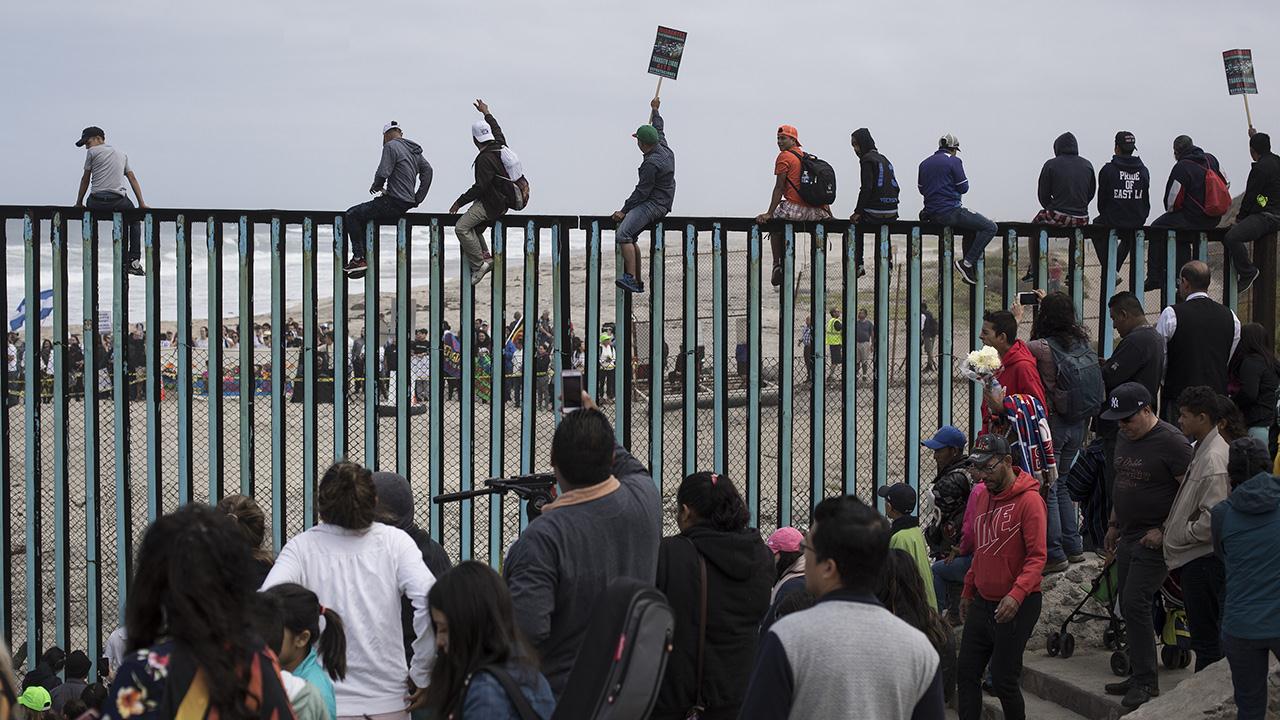
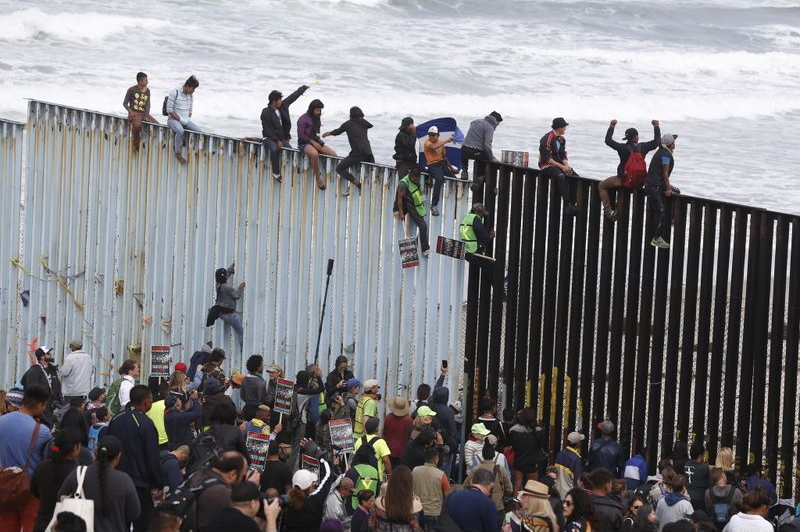
In
1999, Venezuela underwent something of a Cuban-like social revolution,
installing a "popular" dictatorship under Hugo Chavez, in which Chavez
planned to use Venezuela's massive oil earnings to bring Venezuela
under full Socialism. In 2013, Chavez died, and his place was taken by
Nicolás Maduro – who basically continued the Chavez program – including
its strong dislike of America.
But international oil pricing had dropped considerably in those years …
leaving the Venezuelan government no longer able to offer the rewards
of Socialism to its people. In the meantime, huge numbers (about 4
million or 12 percent of the population) of the more entrepreneurial
middle-class Venezuelans had simply abandoned their homeland … as the
country sank rapidly into national poverty.
Trump's response to all this was try to bring down the Maduro government in 2017, by ending oil imports from Venezuela2
- as well as American food and medicine exports to Venezuela. And in
2018, America and the West did what it could to support the more
politically centrist Juan Guaidó in his run for Venezuelan president
that year. But that election was marked by much confusion and
corruption … plus the full support of Maduro by the Venezuelan
military. In any case, the Venezuelan National Assembly (and the West)
concluded in 2019 that Guaidó was the person they would recognize as
"interim president."
But the political reality was that Maduro considered himself properly
elected to a second term as Venezuelan president … and had China,
Russia, Cuba, Iran and even Syria and Bolivia strongly supporting that
claim – in an attempt to block all further American and Western
influence in Venezuela … and to replace that with Chinese, Russian,
etc. influence not only in Venezuela but also in the broader Central
and South American world.
2Anyway,
America really did not need Venezuelan oil as it was basically
oil-self-sufficient by this point, thanks to American shale-oil
production.
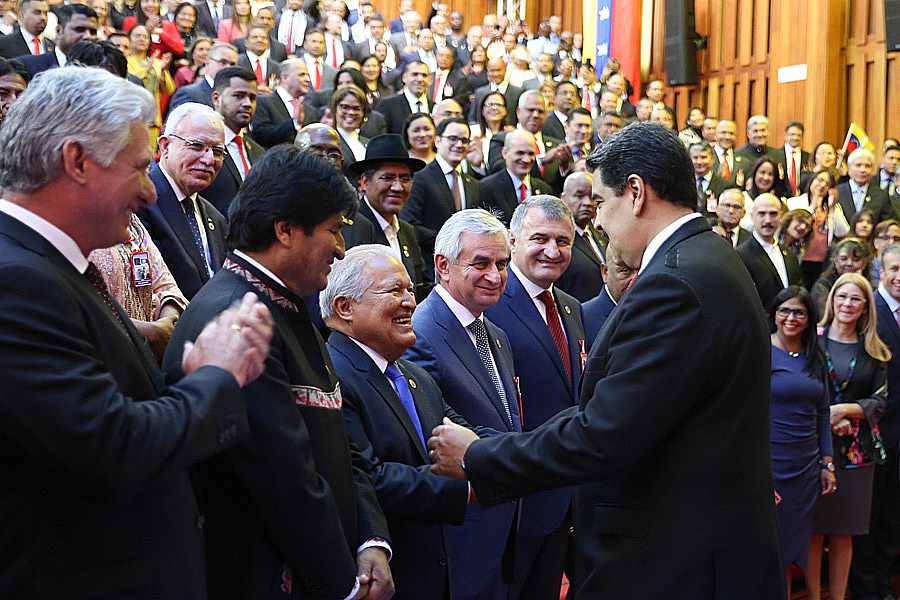
Maduro greeting Salvadoran President (and other Latin America leaders) at Maduro's inauguration
to his second term as Venezuelan president - February 2019
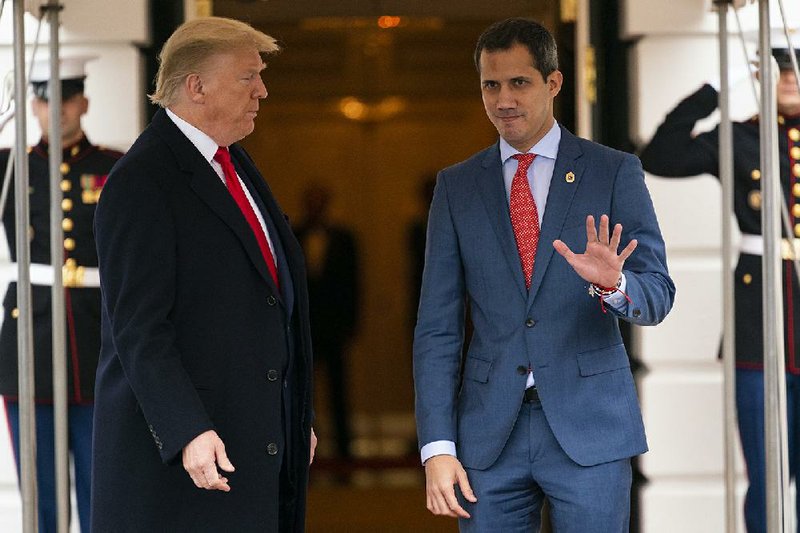
Trump and Guaido - February 2020
Meanwhile,
Xi Jinping moved to make his personal rule even tighter over China,
getting the Chinese National People's Congress in March of 2018 to vote
(2,964 to 2!) to end the Chinese constitution's two-term limit on the
presidency … that had been put in place when Deng Xiaoping brought
China out of its terrible Maoist legacy in the late 1970s/early 1980s.
The presumption supposedly was that putting China under ever-tighter
presidential rule would guarantee the continuing move of China toward a
similar ever-tighter global domination.
And the world of technology factored majorly in advancing China's
international program. With the help of a lot of Chinese government
subsidies, China's electronics communications industries have been able
to capture much of the world market by being able to offer cheaper
products – often just copies of Western technological development … in
complete disregard of the World Trade Organization's international
patent rights. Thus China's telecommunications giant Huawei was able to
move into a position of dominance in the new 5G telecommunications
sector … as well as China's Alibaba and Tencent, who have achieved
monopolistic status in China, move to a position of dominance abroad by
buying out foreign companies.
Trump tried to head off this Chinese move in March of 2018 by imposing
tariffs amounting to $250 billion in Chinese goods coming into America
… in order to bring Chinese pricing closer to American products. But
then China retaliated with a $100 billion tariff against American goods
– although the balance of trade between the two countries was already
heavily in favor of China. To try to work out a compromise between the
two countries, Xi and Trump met at a G-203
summit in Japan in June of 2019 … though little was actually
accomplished. But at least other Western countries moved down the same
trail as Trump, to end the dumping of Chinese goods into their
economies – or having the Chinese subsidized companies buy their
European companies.
Nonetheless, as a sign of China's rising global status, in April of
2019 40 countries gathered in Beijing to celebrate the achievements of
China's "Belt and Road Initiative" – started up in 2013 to integrate
the world's economies with China's economy. Attending were not only
Xi's new partner Putin, but also leaders of African and Middle Eastern
nations. Even leaders from America's traditional partners Italy, Spain,
Greece, Turkey and its new partners Poland, the Czech Republic, and
Hungary – as well as America's Latin American friends Chile and
Argentina – were in attendance. Even Switzerland left its long-standing
neutral position in order to attend the event.
3The
G-20 (Group of 20) constitutes an international forum of the world's
major industrial powers (including the European Union and the new
African Union), formed in 1999 to work out international economic
problems at the time. It meets at least annually to take on such
questions as international trade and finance, but also climate change
and sustainable social development … or any other issue of timely
global socio-economic importance.
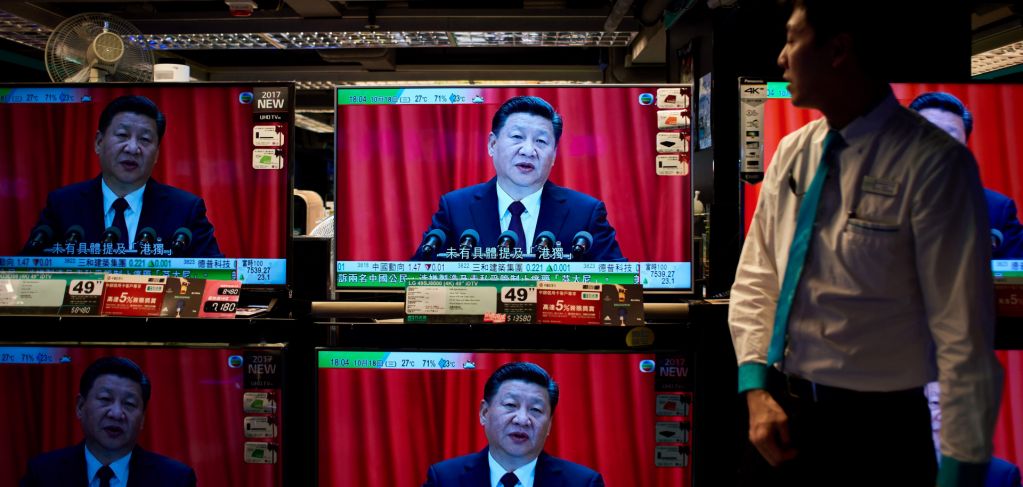
Xi Jinping building Chinese power around his own personal rule
... as if he were founding a new Chinese dynasty!
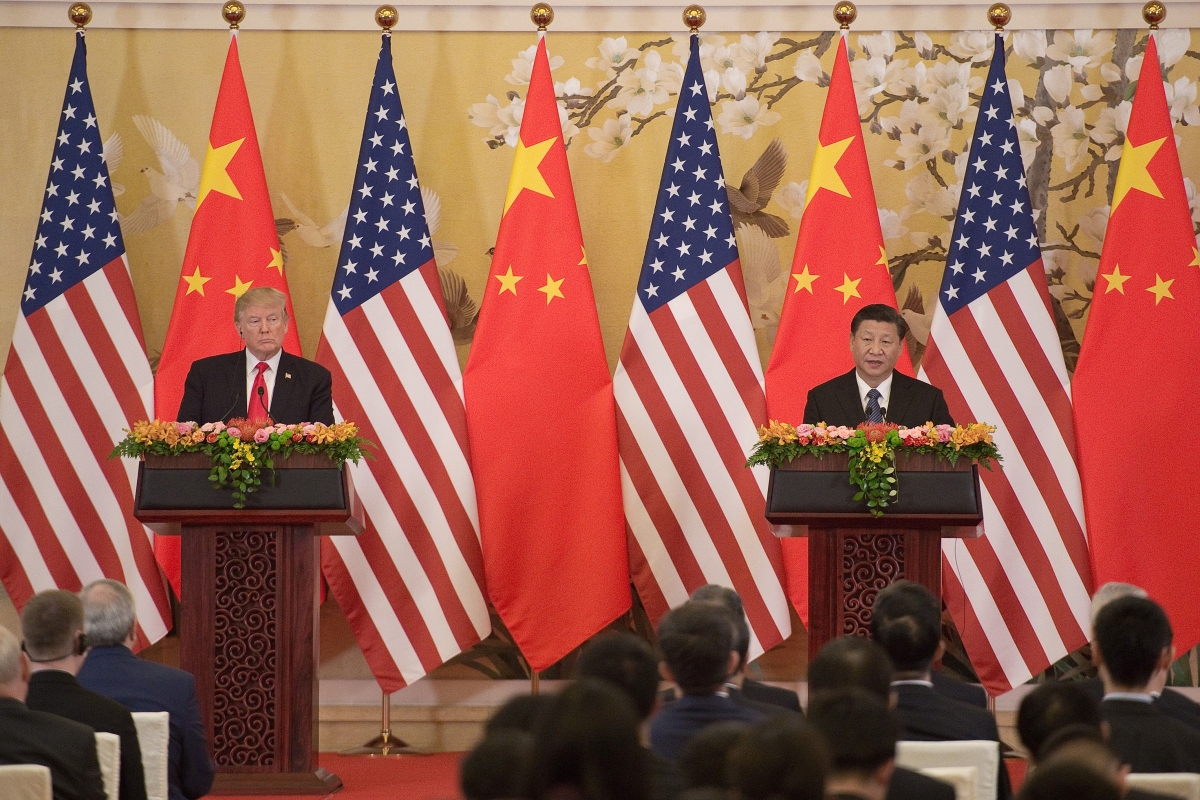
Trump in China - November 9, 2017
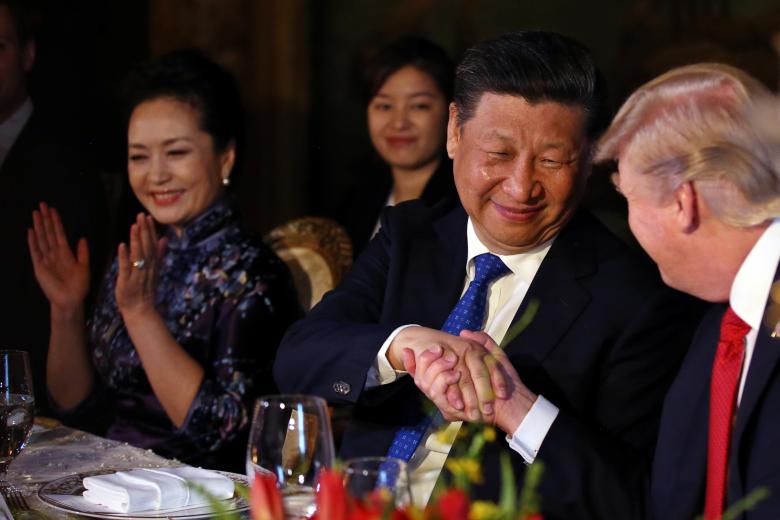
Trump presumed himself able to build better relations with China ... simply on the basis of
his own personal ties with China's President Xi Jinping. He seemed not to understand that
international relations are built largely on foundations of relative national power
... and the willingess of national leaders to use that power.
Clearly
China and Russia had put aside their historic differences (border
disputes in Central Asia) and had come together … for the single
purpose of undercutting American international leadership – and the
Western world looking to America for such leadership. Thus Russia's
"President-for-Life" Putin was quick to join China in swinging to the
support of any country finding itself in some form of contention with
America or the West. And stupid moves by American leaders simplified
that task greatly, as in the way Obama opened the door for Russia to
come to the aid of Assad's Syria … and then Iran when Trump rejected
Obama's treaty with Iran that had opened up Iranian oil sales to the
West and Venezuela when Trump went up against Maduro.
And to further cement the Chinese-Russian connection, Xi and Putin
worked together to develop China's Maritime Silk Road connecting
China's economy more closely with Europe by means of a direct trade
route across the now open waters of the Arctic above Russia's northern
Siberia. At the same time the two countries tied their economies more
closely together by means of a Russian pipeline sending much-needed
natural gas to China … and extensive cooperation in the development of
the new 5G technology – and other modern infrastructure development.
Then too, Russia's natural gas pipeline to Europe – and Germany's
dependence on that Russian gas supply to run its own economy – was
designed to put Russia in a very strong economic position in the
Western economies, once so very dependent on American leadership.
And all of this made the Russians more than glad to have Putin continue
to govern their world. The 1990s experiment in democracy had been
rather disastrous. And thus they were pleased to have Putin take the
responsibility of self-government out of their hands and place that
responsibility solely in his own hands. That was a political pattern
more understandable to the Russians.
Indeed, in a poll taken by the Levada Center4
in 2019, it was revealed that 70 percent of the Russians believed that
Stalin played a completely or relatively positive role in the life of
the country! In short, the clear majority of the Russian people wanted
no further part of whatever it was that America or the European West
had to offer as political Idealism (its "democracy").
4FP Morning Brief (Foreign Policy), January 12, 2021.
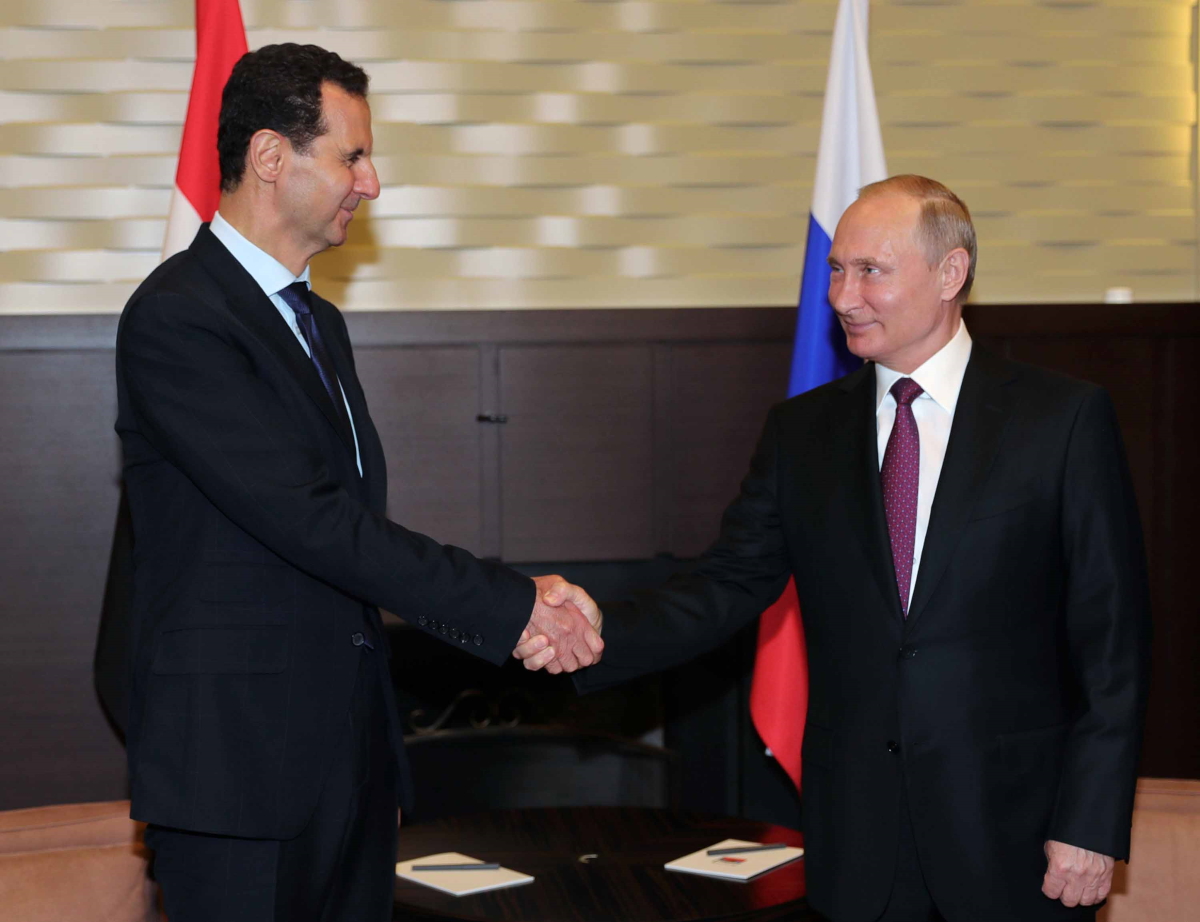
Puting and Assad working closely together (May 2018) -
since the Obama fiasco needlessly alienating Assad in the days of the Arab Spring (2011)
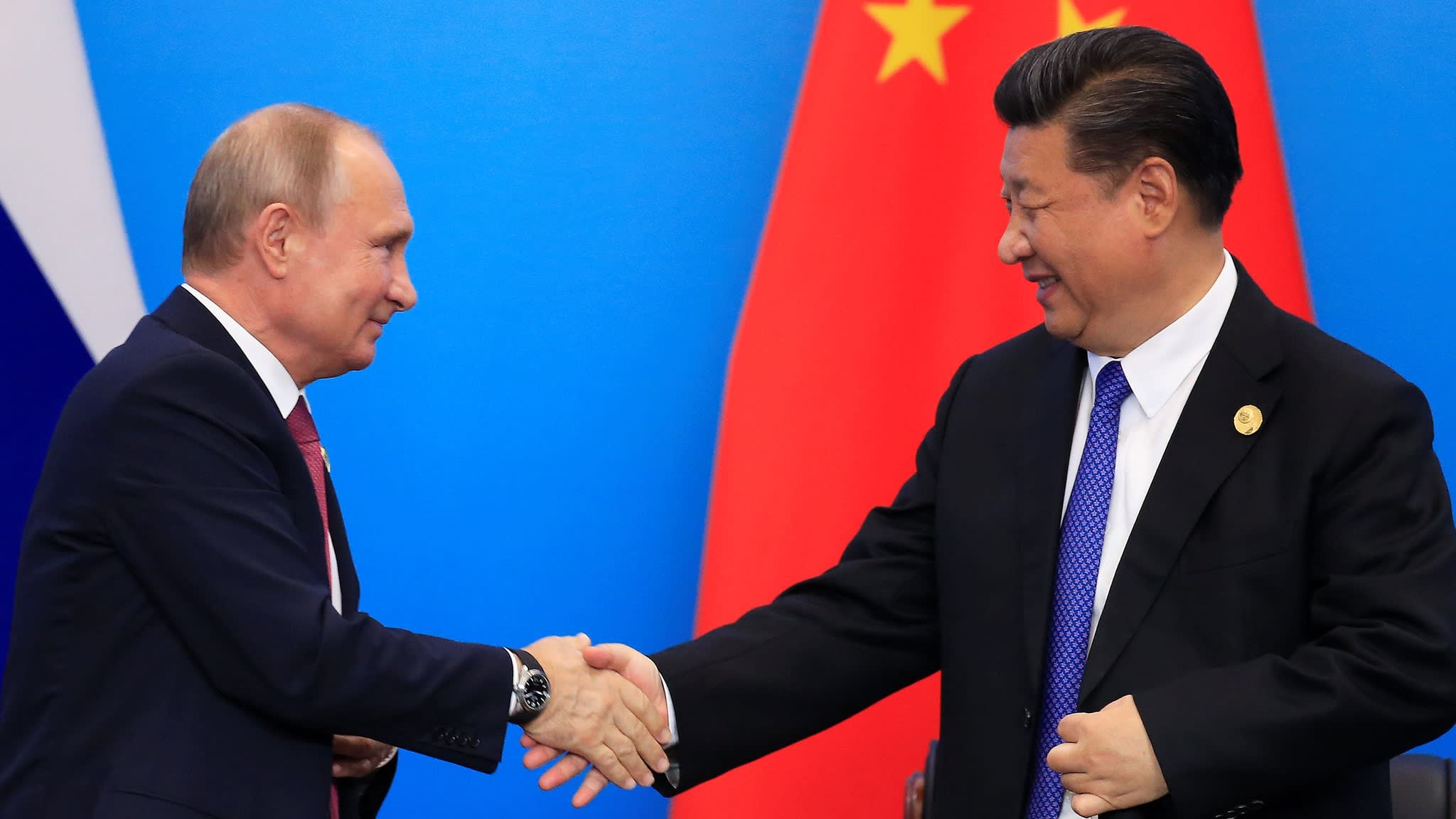
Putin and Xi recognizing that they have more in common rather than deep political differences in their desire to work together against an American-dominated world - June 2018

Likewise, Putin recognizing that he has much to gain in helping Maduro stay in power in Venezuela
(February 2020)
One
of the great tragedies involving American leadership was the inability
of its executive officers to understand the very complex cultural
underlay of the various "nations" of the Middle East. These Middle
Eastern states were societies highly divided by strongly opposing
religious subcommunities – plus a huge division in their societies over
this matter of what to do about the intruding Western cultural
challenge. Bush and Obama somehow simply supposed that the Middle East
was waiting anxiously to bring Western style democracy to their
societies … not realizing that this matter was already throwing Middle
Eastern societies into horrible turmoil. While certainly there were
those hoping for just such cultural change to come their way, this
small group of Middle Easterners were more than offset by an even
bigger group of Middle Easterners very, very hostile to the West and
its ways. Thus 9/11. Thus Iran's "Death to the Great Satan America."
Thus ISIS and the new Muslim Caliphate in the war-torn zone of Western
Iraq and Eastern Syria. Thus even the long-time American NATO ally
Turkey, taking on a more traditional Muslim look.
We have already noted that Obama finally made the shift away from
trying to overthrow Muslim dictatorships … by at least attempting to
improve relations with the Ayatollah's Iran. But with Trump coming to
the White House, that nuclear-development agreement was put aside –
Trump being quite certain that any country whose motto was "Death to
America" was not one to be trusted … particularly with Iran also
drawing ever-closer to America's major international opponents, China
and Russia. Trump was certain that continuing to appease Iran with this
or that diplomatic reward was not likely to back Iran away from its
sense that in alliance with China and Russia, Iran had a much bigger
game to play internationally.
At the same time, Trump was of the mindset that it was time to back
America out of its very expensive involvement in Middle Eastern affairs
… at least in terms of American ground troops stationed here and there
in the effort to support or oppose this or that regime. Thus it was
that he made the decision to withdraw American troops from Syria … and
then begin negotiations in anticipation of a similar American
withdrawal from Afghanistan. In this he was willing to work with even
the Afghan Taliban and Afghanistan's various tribal leaders … for a
scheduled withdrawal as of May 2021 (Trump presuming that he would be
reelected to a second term as U.S. president at that point).
By this, Trump did not mean the withdrawal of American national
interest in the Middle East … only a change in strategy. Indeed, in
anticipation of his Syrian withdrawal, Trump ordered a brief but highly
effective step up of an American air and ground offensive directed at
the Islamic Caliphate … and brought the Caliphate to collapse with a
massive American bombing in January of 2019. This did not end the
Islamic spirit of jihadism. But it weakened it considerably with this
demonstration of American resolve.
Trump then worked to strengthen the American position in the Persian
Gulf region … by beefing up America's naval presence there (and
irritating the Iranians majorly), by selling arms to Saudi Arabia, and
by leading Arab states of the region (Bahrain and the United Arab
Emirates) to come to new diplomatic agreements with Israel … strong
diplomatic moves that were largely ignored by the mostly very Liberal
American press – which was in no mood to acknowledge any Trump
political or diplomatic achievement.
THE CHAOTIC 2020 AMERICAN NATIONAL ELECTIONS |
The
Republicans again chose Trump and Vice President Mike Pence to be their
candidates for the 2020 presidential race. And the Democrats chose the
former Vice President and veteran DC politician Joe Biden to represent
them in that race … an amazing choice considering the fact that Biden
was only two years short of his 80th birthday. Biden then announced
that he would be selecting a "woman of color" to be his running mate …
a category rather than a particular individual being of greatest
interest to him. He finally ended up selecting Kamala Harris, a U.S.
Senator from California since 2017 and California Attorney General
prior to that (2011-2017).
Tragically, the pandemic would add to the very unusual way that the
election was conducted. From the selection of the candidates to the
actual voting, actual physical participation was greatly handicapped by
the new public participation restrictions. Thus the conventions of both
parties were conducted mostly through online participation … and the
vote itself in November was done heavily by means of mail-in ballots.
But that in itself would become a matter of great political debate … as
the Republicans complained that mail-in voting easily led to fraud (no
way to check to see who actually sent in the ballot or what actually
happened to the ballots once sent out). The Democrats took the position
that this made voting much easier – and more just … especially since it
was well-known that the voters who did not bother to come out to vote
at the local polling stations tended to be Democrats.
Ultimately, over 81 million votes went to Biden and over 74 million
votes went to Trump. This was the largest number ever of votes cast in
an American presidential election, with both candidates (even Trump)
receiving more votes than any previous candidate. But Trump would not
follow the long-standing tradition of graciously accepting the
electoral verdict … but immediately went to a counterattack, claiming
(without any specific evidence) that Biden had won the election
strictly through voter fraud. And he would not back down from that
position, even after Trump's Attorney General William Barr announced
that an extensive FBI investigation into the matter found no evidence
supporting the idea that Biden had won through widespread fraud. But
still, Trump would not let up but did what he could to throw enough
state elections into question (most notably in Georgia, Michigan,
Nevada and Pennsylvania) in his effort to get the electoral vote to go
in his favor. Nonetheless, on December 14th the Electoral College was
called on to decide the vote … confirming Biden as the winner of the
national election.
Then when on January 6th, Congress convened to give official
authorization to the election and its results, Trump simultaneously
called for a gathering in front of the White House … where he continued
to complain about the fraudulent nature of the election – and then
directed this massive crowd to head over to Capitol Hill to protest the
election. This they did … in the process going crazy with their protest
spirit, even invading the Capital Building itself – and sending the
assembled legislators scrambling for safety. In all this mayhem, a
female Trump supporter was shot and killed, several protesters died
(presumably from medical emergencies), and numerous officers were hurt
badly, one dying from his wounds, before they could be cleared out.
Many of the participants would later be identified and arrested for
what was clearly a federal crime.
Once again, demands for the impeachment of Trump resulted (the third
such effort) … and indeed on the 13th of the month the House
successfully voted exactly that. But the 2/3rds requirement in the
Senate for an actual conviction failed, with 57 Senators (including 7
Republicans) voting to convict and 43 Senators (all Republicans) voting
to acquit.
And Inauguration Day (January 20th) then followed … with Trump refusing
to participate in the formal installation of the new president.
But private-citizen Trump would not simply slip off into quiet
presidential retirement … for he himself had added considerably to the
resolve of his political adversaries (enemies actually at this point)
to put him behind bars as a common criminal.
|

The vote goes in favor of Biden in the 2000 national elections ...
disputed by Trump, who claims that massive fraud was involved in Biden's victory
On January 6, 2021, the members of the House of Representatives
gathered to certify the electoral college vote.
That same day, Trump decided to hold a rally at the White House in protest of
the "fraudulent" elections ... and then called on his supporters to march on Capitol Hill
to protest the day's "illegal" action.
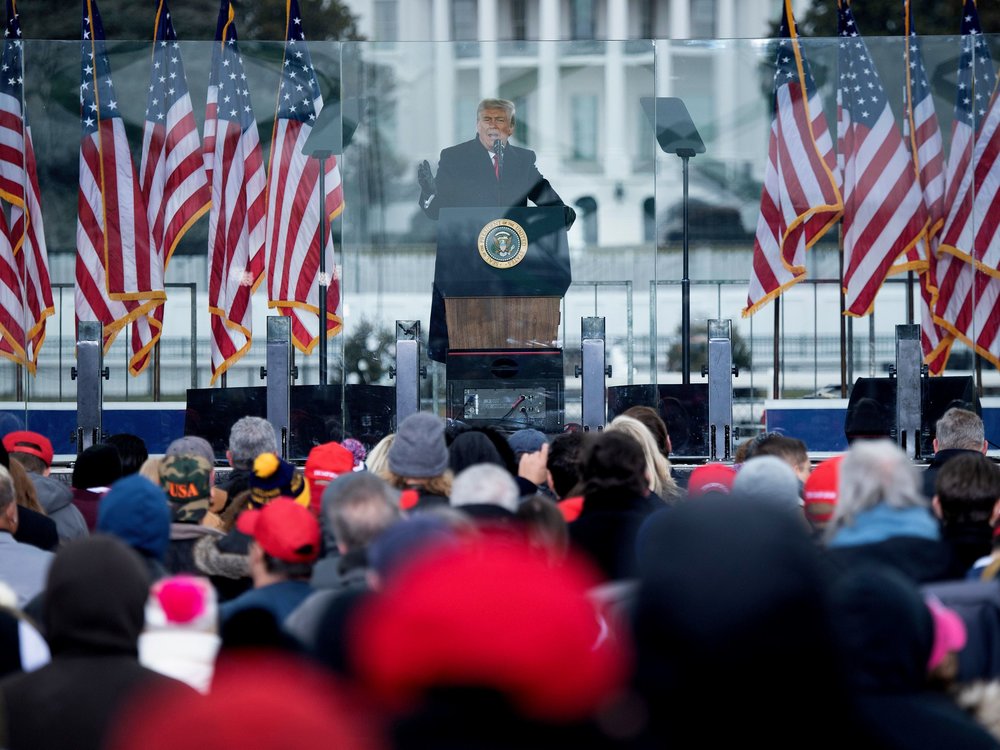
This they did ... failing to merely gather in front of the Capitol Building but choosing instead to invade it ... seemingly typical of the way protests had been conducted lately.
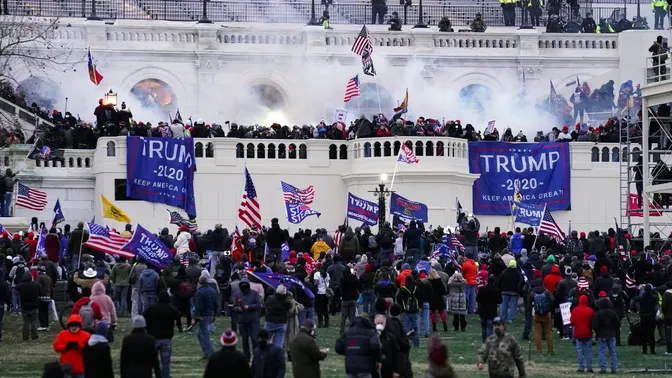
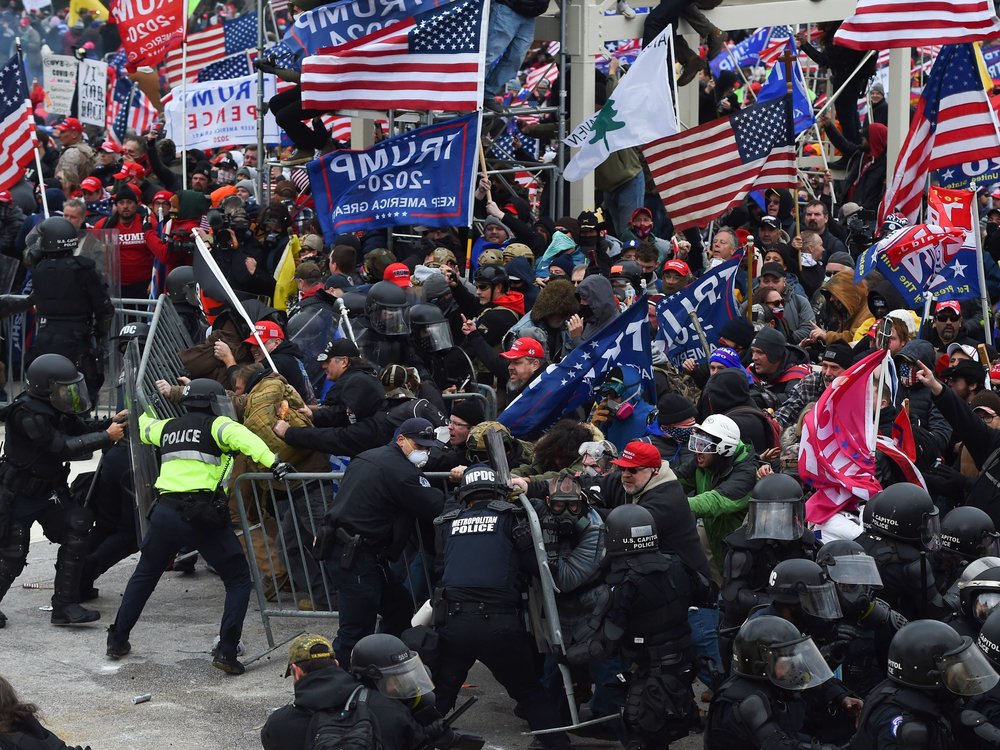
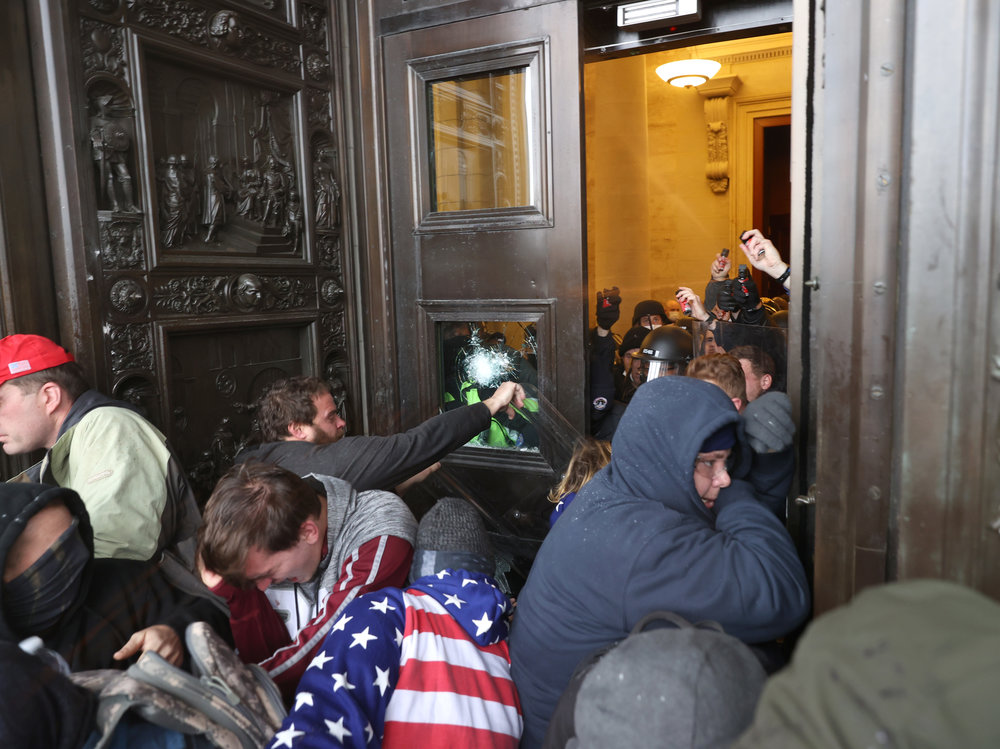
In the process, Representative stopped the vote and went into hiding
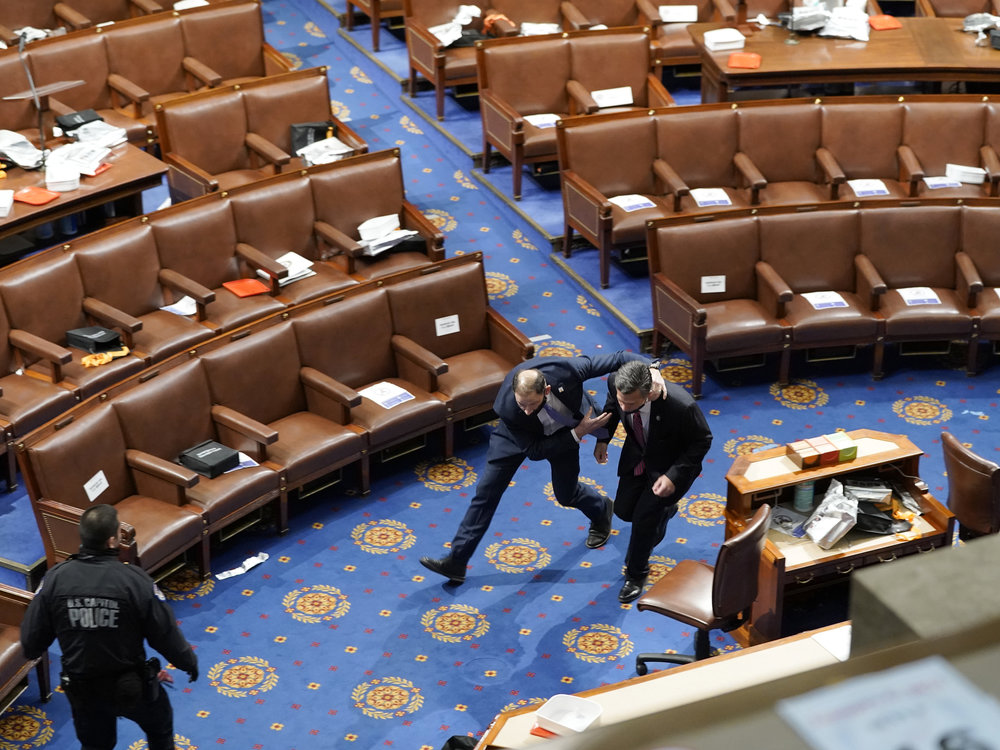
The National Guard was eventually called out to help the Capitol police
In the melee, one protester was shot, numerous people wounded
including a policeman who later died of his wounds
and others died of medical conditions that could not be attended to.
It was a terrible show of a president leaving office.
And it would, of course, become grounds for a new impeachment effort
... voted on by Pelosi's House on January 13th, 232-197 after a 2-day hearing
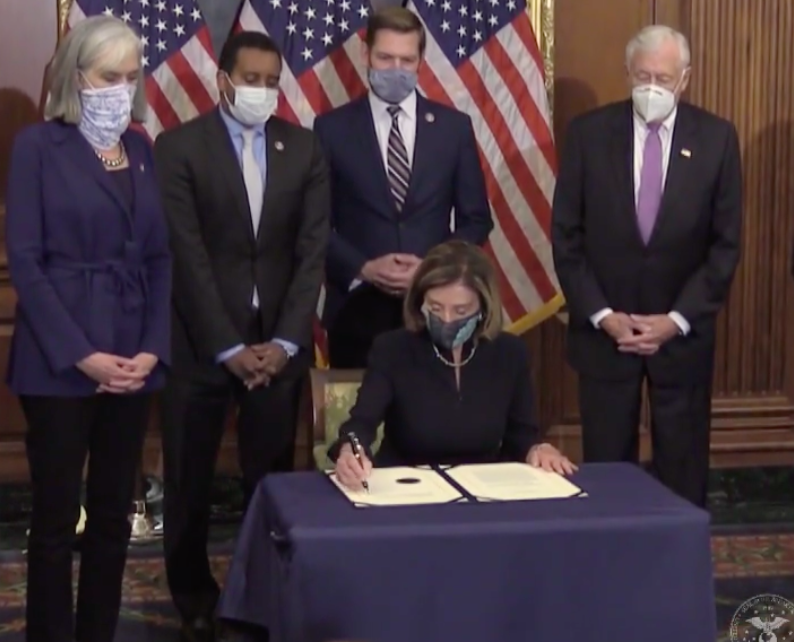
And thus it was that Trump ended his presidency
... refusing to attend Biden's inauguration on January 20th
However, action against Trump would continue ... even with America under a new president. This would be led by Congress's House Select Committee (created in July of 2021)
charged to investigate the January 6th events ... in the effort to come up with criminal charges against Trump (fraud, criminal conspiracy).
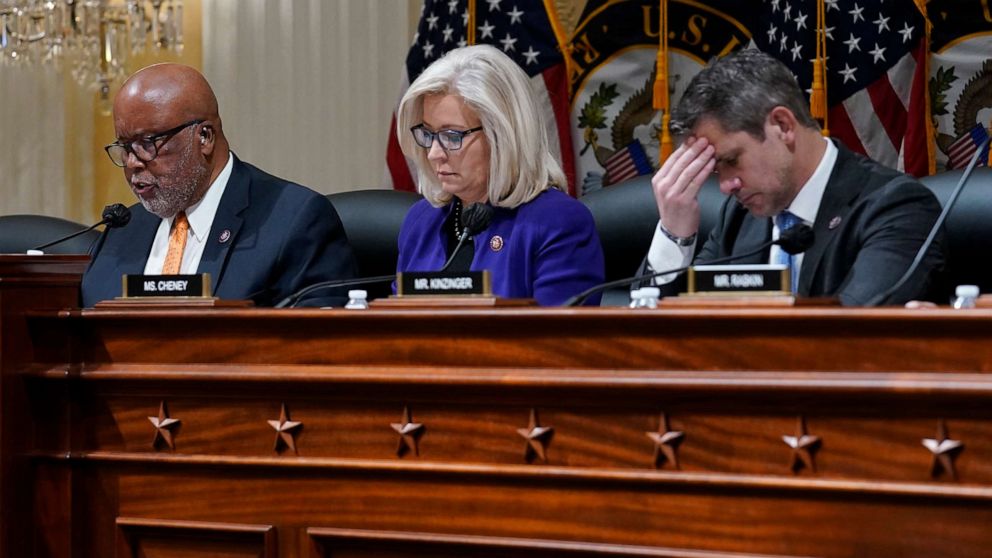
The House Committee is made up of 7 Democrats and 2 Republicans. One of the Republicans is Liz Cheney ... who clearly wants to see Trump put away ... and the other is Adam Kinzinger ... the only two Republicans willing to serve on the committee.
 Miles
H. Hodges Miles
H. Hodges
| | | | | |


 The 2016 elections
The 2016 elections
 The Coronavirus disease - 2019
The Coronavirus disease - 2019 The political outfall in America
The political outfall in America
 The American immigration crisis
The American immigration crisis
 The chaotic 2020 American national
The chaotic 2020 American national






















































